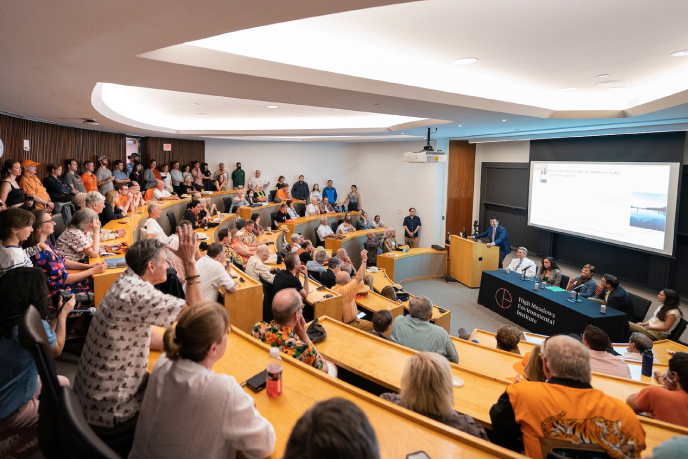Meet Our Past Interns - 2023
- Biodiversity and Conservation
-
Burghardt, Meera ’24
School of Public and International Affairs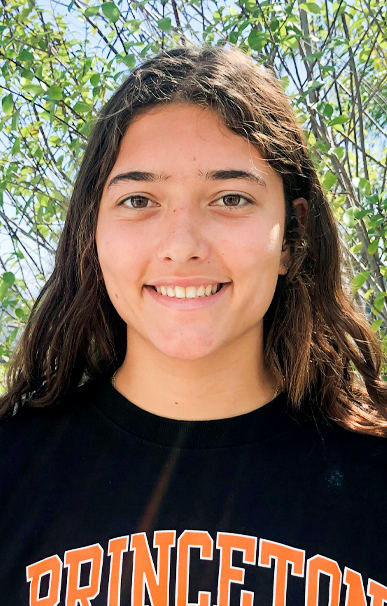 PROJECT
PROJECTPromoting Pro-conservation Behaviors in Recreational Scuba Divers on Coral Reefs in Southeast Asia
ORGANIZATION / LOCATIONWilcove Lab, Department of Ecology and Evolutionary Biology, Princeton University - Bali, Indonesia; Malapascua, Philippines; Panglao, Philippines
MENTOR(S)David Wilcove, Professor of Ecology and Evolutionary Biology and Public Affairs and the High Meadows Environmental Institute; Bing Lin, Ph.D. candidate, School of Public and International Affairs
Certificate(s): Applications of Computing, Environmental Studies
I traveled across Southeast Asia researching environmental attitudes and behaviors among recreational scuba divers. Bailey White and I worked together with our mentor, Bing Lin, to collect various types of data that will be used to make conclusions on the impact of recreational scuba diving on coral reefs. Coral reefs are dying at an alarming rate, and recreational scuba diving is one of the many human interactions causing their decline. In one facet of the research, we collected video footage of scuba divers during their dives and observed their interactions with the reef. We also conducted surveys to assess environmental attitudes among divers. This research will hopefully give insights into the specifics of how recreational scuba diving is hurting coral reefs that can be used to develop policy recommendations that promote pro-conservation attitudes and behaviors.
-
Demefack, Emma ’26
Ecology and Evolutionary Biology
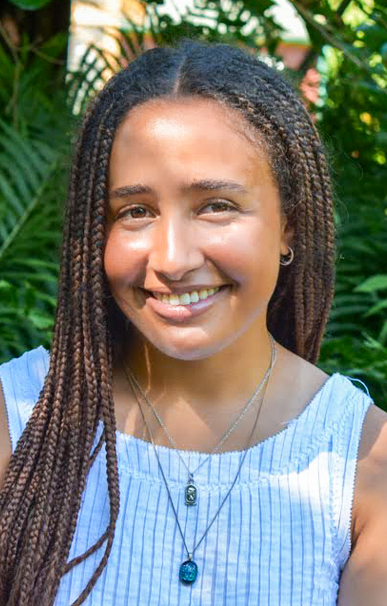 PROJECT
PROJECTClimate-change Mediated Evolutionary Shifts in a High-alpine Hibernating Mammal
ORGANIZATION / LOCATIONvonHoldt Lab, Department of Ecology and Evolutionary Biology, Princeton University - Rocky Mountain Biological Laboratory, Gothic, Colorado
MENTOR(S)Bridgett vonHoldt, Associate Professor of Ecology and Evolutionary Biology, Princeton University; Daniel Blumstein, Professor, Department of Ecology and Evolutionary Biology, University of California, Los Angeles; Stavi Tennenbaum, Ph.D. candidate, Ecology and Evolutionary Biology, Princeton University
I worked as a field technician and research assistant on the Marmot Project, a historic study that began in 1962 and is one of the world’s longest-running studies of mammals in the wild. At the Rocky Mountain Biological Laboratory in Gothic, Colorado, I worked alongside a high-energy field team of undergraduates, graduate students and postdoctoral researchers. My day-to-day responsibilities included taking behavioral observations, trapping and handling live animals, collecting biological samples such as blood and feces, performing timed running trials, taking morphological measurements, processing samples and managing our database. Additionally, I collected data to study the genomic responses of hibernating marmots to climate changes in high-alpine meadows in the Rocky Mountains. This meant focusing on drawing blood and preserving the blood’s RNA. Although the fieldwork was challenging, I ultimately found it very rewarding. I learned valuable technical fieldwork skills and a better understanding of high-alpine ecology, specifically within mammals. As a result, I now have a deeper curiosity about studying the evolutionary biology of other animals.
-
Dorini, David ’25
Ecology and Evolutionary Biology
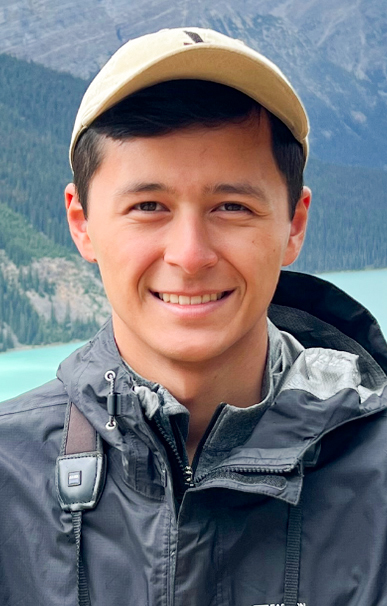 PROJECT
PROJECTUnderstanding Biodiversity Loss in Large Tropical Forest Fragments
ORGANIZATION / LOCATIONWilcove Lab, Department of Ecology and Evolutionary Biology, Princeton University - Mato Grosso, Brazil
MENTOR(S)David Wilcove, Professor of Ecology and Evolutionary Biology and Public Affairs and the High Meadows Environmental Institute; Alex Wiebe, Ph.D. candidate, Ecology and Evolutionary Biology
I worked on a project studying the effects of forest fragmentation on bird communities in the Brazilian Amazon. Forest fragmentation is an issue for birds and biodiversity in general. It is a particularly important issue in the face of the widespread deforestation in the Brazilian Amazon, an area known for its enormous biodiversity. We conducted fieldwork in Mato Grosso, Brazil to examine forest fragments of diverse sizes. In each fragment, I assisted with a series of point counts to document every individual bird that was heard or seen from each point. I also assisted with surveys of mixed species flocks, which provided a different method of sampling bird communities in each fragment, and environmental surveys to document leaf litter depth and the number of groundcover plants in different transects throughout each fragment. I gained a focused understanding of habitat fragmentation and mechanisms of species loss and a greater understanding of concepts in ecology and biology more generally. It was particularly rewarding to see concepts that I had studied in class applied in the field, and I hope to further study some of these concepts in my own research at Princeton.
-
Gilbert, Claire ’26
Neuroscience
 PROJECT
PROJECTNaturalizing the Environmental Experience of “Model Mammals” for Immunology and Beyond
ORGANIZATION / LOCATIONThe Graham Group, Department of Ecology and Evolutionary Biology, Princeton University - Princeton, New Jersey
MENTOR(S)Andrea Graham, Professor of Ecology and Evolutionary Biology; Yoon Chang, Ph.D. candidate, Ecology and Evolutionary Biology; David Chang van Oordt, Postdoctoral Research Associate, Ecology and Evolutionary Biology; Alec Downie, Ph.D. candidate, Ecology and Evolutionary Biology
I investigated immunological and social behavioral differences between lab mice that were “rewilded” — returned to nature in an outdoor enclosure at the Stony Ford Research Station — and those that remained in the lab. The Graham Group studies how the outdoor environment could affect the mice’s ability to fight off parasites and how mice’s social behavior could contribute to their immune profiles. I performed husbandry checks on the rewilded mice to ensure they had adequate food, water and shelter and to ensure their physical safety from predators. I analyzed data collected from radio-frequency identification tags, which had been implanted into each mouse to determine the number of mice that were active each day and to check whether any mice had escaped. I collected camera footage from select locations in the mice enclosure to track specific behaviors such as eating, fighting and climbing, which contributes to our understanding of how the mice interact with each other and their environment. Overall, the project gave me the opportunity to acquire fieldwork and laboratory skills, and experience in a new coding language. I deeply enjoyed the time in nature and working with a supportive network of researchers.
-
Houlahan, Grace ’25
Psychology
 PROJECT
PROJECTComparing Large Mammal Behavior Across Two African-protected Areas
ORGANIZATION / LOCATIONPringle Lab, Department of Ecology and Evolutionary Biology, Princeton University - Gorongosa National Park, Mozambique
MENTOR(S)Robert Pringle, Professor of Ecology and Evolutionary Biology; Joel Abraham, Ph.D. candidate, Ecology and Evolutionary Biology; Erin Phillips, Ph.D. candidate, Ecology and Evolutionary Biology
I worked with the Pringle Lab in Gorongosa National Park, Mozambique, under the supervision of Joel Abraham. In Gorongosa, ecological disturbances such as fire, flooding and herbivory affect plant life and ecosystems. Our research goal was to determine and understand how these disturbances interact and affect the savanna. To do this, we quantified the abundances of herbivores and invertebrates to understand herbivory presence, implemented flood sensors to measure flood levels, and collected soil cores to analyze soil composition. These methods were sometimes tedious, but I found my field work extremely rewarding. Along with these various sampling methods, I learned about the unique history of Mozambique and how enjoyable field research can be in a team environment.
-
Huan, Mulin ’26
Ecology and Evolutionary Biology
 PROJECT
PROJECTSeasonal Evolution of Fruit Fly Competitive Ability
ORGANIZATION / LOCATIONLevine Lab, Department of Ecology and Evolutionary Biology, Princeton University - Princeton, New Jersey
MENTOR(S)Jonathan Levine, J.N. Allison Professor in Environmental Studies, Professor of Ecology and Evolutionary Biology; Jamie Leonard, Ph.D. candidate, Ecology and Evolutionary Biology
I studied how fruit fly phenotypes such as heat tolerance, starvation tolerance, chill coma recovery and fecundity can rapidly evolve over a few months and used experiments to examine how these rapid evolutions affect their competitive abilities. I set up a field experiment site with fly cages and tents at the Princeton University nursery but ran into several issues when storms knocked down the tents and cages. However, my adviser and I came up with ideas to fix the problem. I also took part in making food for all the flies and recording data during the phenotyping of the flies. I learned many techniques, especially skills involving collecting and sampling flies from orchards and cages. As a rising sophomore, this opportunity offered me great insights including how to work safely and efficiently in a university laboratory and deal with unexpected challenges in the field. Overall, I developed further confidence in my aspired career as a researcher in ecology and evolutionary biology.
* This internship is connected to the HMEI Biodiversity Grand Challenges project, “The Maintenance of Species Diversity through the Rapid Evolution of Competitive Ability.”
-
Kim, Chloe ’24
History
 PROJECT
PROJECTBroad-tailed Hummingbird Foraging Patterns and Climate Change
ORGANIZATION / LOCATIONStoddard Lab, Department of Ecology and Evolutionary Biology, Princeton University - Rocky Mountain Biological Laboratory, Gothic, Colorado
MENTOR(S)Mary C. Stoddard, Associate Professor of Ecology and Evolutionary Biology; Benedict Hogan, Associate Research Scholar, Ecology and Evolutionary Biology; Audrey Miller, Ph.D. candidate, Ecology and Evolutionary Biology
Certificate(s): Environmental Studies
I collected data on broad-tailed hummingbird feeding and wildflower availability to add to a long-term dataset maintained by the Stoddard Lab. My research partners and I identified flower species that hummingbirds are known to visit at the Rocky Mountain Biological Laboratory and set camera traps on these flowers to record hummingbird visits. We also used this dataset to investigate whether changes in daily temperature affect hummingbird foraging patterns. The fieldwork component of this project taught me to be a careful observer and appreciator of my environment, and I also learnt the value of repetitive work and the importance of diligence and detail. This research experience has strengthened my data analysis skills and taught me to be critical and curious. I plan to continue conducting research at Princeton and am excited to work closely alongside other scientists who are passionate about the environment
* This internship is connected to the HMEI Climate and Energy Grand Challenges project, “Investigating the Effects of Climate Change on Hummingbird Sensory Landscapes.”
-
Kumar, Rohan ’26
Undeclared
 PROJECT
PROJECTInvestigating the Structure and Composition of Dung Beetle Food Webs in an African Savanna
ORGANIZATION / LOCATIONPringle Lab, Department of Ecology and Evolutionary Biology, Princeton University - Mpala Research Centre, Laikipia, Kenya
MENTOR(S)Robert Pringle, Professor of Ecology and Evolutionary Biology; Finote Gijsman, Ph.D. candidate, Ecology and Evolutionary Biology
I helped investigate the structure, stability and complexity of species interaction networks between large mammalian herbivores and dung beetles in African savannas. Dung beetles are vital for ecosystem functioning, but their diversity, distribution and associations with mammals in these ecosystems are not fully understood. Moreover, dung beetles are at risk of extinction due to their vulnerability to environmental and anthropogenic disturbances, and this risk is exacerbated by the alarming reductions in large herbivore population reduction and growing human-environment interference. Understanding the beetles and their food webs is essential for their conservation. To learn more about beetle diversity in the presence of various savanna herbivores, I helped collect and process herbivore dung samples and surveyed dung beetles at various locations. I also assisted with laboratory trials to assess beetle food preferences. To improve species identification ability and create a large public database, I helped set up DNA barcoding plates and photographed dung beetle specimens for morphological trait measurements. I also aided in dissecting beetles so that their gut contents could be metabarcoded. The whole experience was incredibly rewarding as I gained an invaluable glimpse into the world of evolutionary and ecological biology research.
-
Mhando, Brian ’26
Ecology and Evolutionary Biology
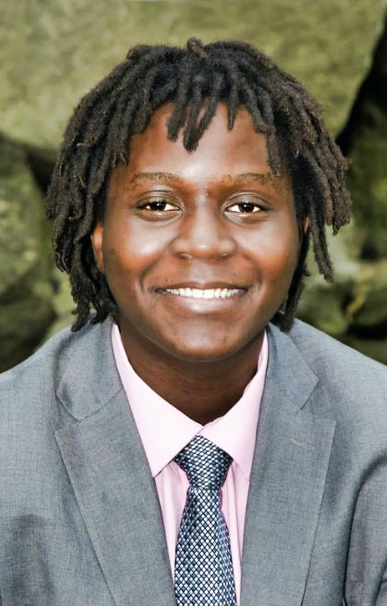 PROJECT
PROJECTUnderstanding Biodiversity Loss in Large Tropical Forest Fragments
ORGANIZATION / LOCATIONWilcove Lab, Department of Ecology and Evolutionary Biology, Princeton University - Mato Grosso, Brazil
MENTOR(S)David Wilcove, Professor of Ecology and Evolutionary Biology and Public Affairs and the High Meadows Environmental Institute; Alex Wiebe, Ph.D. candidate, Ecology and Evolutionary Biology
Certificate(s): African American Studies, Global Health and Health Policy
I analyzed the impact of habitat fragmentation on bird populations in the Amazon rainforest. Over the past few years, huge tracts of land have been deforested for farm use, leaving the current landscape of the southern Amazon unrecognizable. In the field, I worked alongside doctoral candidate Alex Wiebe to conduct bird point counts each morning, and in doing so I learned how to identify some species of birds by sight and sound. I also collected environmental data by conducting understory tree surveys in eight meter transects. This project has helped me better understand the importance of understory and canopy trees for maintaining biodiversity in bird populations. What intrigued me the most were the possible political causes of biodiversity loss, such as the international demand for more farmland. Participating in this project has made me consider more career paths that bridge ecological concerns with public policy advocacy.
-
Newcombe, Patrick ’25
Ecology and Evolutionary Biology
 PROJECT
PROJECTCompetition, Coexistence and Carnivores: Intraguild Dynamics of Understudied Mesocarnivores in a Recovering African Savanna
ORGANIZATION / LOCATIONPringle Lab, Department of Ecology and Evolutionary Biology, Princeton University - Gorongosa National Park, Mozambique
MENTOR(S)Robert Pringle, Professor of Ecology and Evolutionary Biology; Erin Phillips, Ph.D. candidate, Ecology and Evolutionary Biology
Certificate(s): African Studies, History and the Practice of Diplomacy
I investigated the dynamics of carnivore competition and coexistence in Gorongosa National Park, Mozambique, a setting of conservation and development. I worked with doctoral candidate Erin Phillips, who’s mentorship granted me incredible experience in experimental design, diverse methods and on-the-ground insights. I conducted a manipulative field experiment to better understand fear-induced responses to a perceived threat. I learned and executed a variety of field methods, including carnivore capture and collaring, remote camera trapping, environmental DNA swabbing, soil sampling and dietary metabarcoding. I also gained exposure to vulture banding and antelope collaring and engaged in many discussions with Pringle Lab members and scientists that enhanced my understanding of ecological dynamics. I visited the forest restoration project, worked closely with the park’s rangers and discussed the park’s conservation and development strategies with staff at all levels of the organization, which gave me insight into challenges, creative solutions and opportunities that emerged over the park’s history. I spent time in the buffer zone and heavily populated parts of Mount Gorongosa, where public-private partnership leverages conservation to alleviate poverty and advance human rights — granting vital lessons in what it means for one African national park to be a “Park for Peace.”
-
Ngo, Trang ’25
Ecology and Evolutionary Biology
 PROJECT
PROJECTBroad-tailed Hummingbird Foraging Patterns and Climate Change
ORGANIZATION / LOCATIONStoddard Lab, Department of Ecology and Evolutionary Biology, Princeton University - Rocky Mountain Biological Laboratory, Gothic, Colorado
MENTOR(S)Mary C. Stoddard, Associate Professor of Ecology and Evolutionary Biology; Benedict Hogan, Associate Research Scholar, Ecology and Evolutionary Biology; Audrey Miller, Ph.D. candidate, Ecology and Evolutionary Biology
Working at the Rocky Mountain Biological Laboratory (RMBL) in Gothic, Colorado I contributed to a long-term field dataset that the Stoddard Lab began collecting in 2018. Named the HummerFlowerWatch project, the data looks at broad-tailed hummingbirds’ foraging patterns. I collaborated with two other interns, and our daily routine including upkeep and monitoring of cameras at our sites and collecting flower abundance data. Our group also participated in RMBL’s undergraduate research program, which entails designing a research project and presenting it to the scientific community there. Our research question examined whether daily temperature changes affect hummingbirds’ foraging activities. This internship taught me the importance of collaboration and gave me a glimpse into the world of field biology and how to conduct a professional scientific project. It has inspired me to pursue this as a potential future career and prompted ideas for my senior thesis.
* This internship is connected to the HMEI Climate and Energy Grand Challenges project, “Investigating the Effects of Climate Change on Hummingbird Sensory Landscapes.
-
Thurber, Michelle ’26
Ecology and Evolutionary Biology
 PROJECT
PROJECTBroad-tailed Hummingbird Foraging Patterns and Climate Change
ORGANIZATION / LOCATIONStoddard Lab, Department of Ecology and Evolutionary Biology, Princeton University - Rocky Mountain Biological Laboratory, Gothic, Colorado
MENTOR(S)Mary C. Stoddard, Associate Professor of Ecology and Evolutionary Biology; Benedict Hogan, Associate Research Scholar, Ecology and Evolutionary Biology; Audrey Miller, Ph.D. candidate, Ecology and Evolutionary Biology
I worked with a team of researchers to collect data on broad-tailed hummingbird foraging patterns. My teammates and I placed motion-sensing cameras on wildflower species at the Rocky Mountain Biological Laboratory (RMBL) in Gothic, Colorado and recorded broad-tailed hummingbird visits. This project is part of a long-term study on how climate change affects wildflower blooms and hummingbird foraging patterns. As participants in RMBL’s Summer Education Program, we also investigated the effect of shorter-term temperature variation on hummingbird visitation rates using data collected by previous HMEI interns. We did not find evidence of a relationship between temperature and visitation rate, which was an intriguing result for a tiny, fast-moving bird that we thought would require even more frequent refueling of nectar during colder temperatures. This was my first experience doing research and writing a scientific paper, and it was also my first time climbing a mountain and seeing the Milky Way. My summer of complete immersion in nature, through science and my adventures, transformed me in many ways. As a result, I’ve become interested in helping others connect with birds, stars, mountains or whatever elements of nature speak to them.
* This internship is connected to the HMEI Climate and Energy Grand Challenges project, “Investigating the Effects of Climate Change on Hummingbird Sensory Landscapes.”
-
White, Bailey ’25
Ecology and Evolutionary Biology
 PROJECT
PROJECTPromoting Pro-conservation Behaviors in Recreational Scuba Divers on Coral Reefs in Southeast Asia
ORGANIZATION / LOCATIONWilcove Lab, Department of Ecology and Evolutionary Biology, Princeton University - Bali, Indonesia; Malapascua, Philippines; Panglao, Philippines
MENTOR(S)David Wilcove, Professor of Ecology and Evolutionary Biology and Public Affairs and the High Meadows Environmental Institute; Bing Lin, Ph.D. candidate, School of Public and International Affairs
Certificate(s): Environmental Studies
I investigated the behavior of recreational scuba divers on coral reefs in the Philippines and Indonesia. These countries lie within the Coral Triangle, the most biodiverse marine ecosystem on the planet. Coral reefs are hotspots of ecotourism, yet tourists such as scuba divers can damage a reef by intentionally or accidentally touching the coral. This project aimed to collect data on the prevalence of contacts between divers and reef by recording divers underwater. I reviewed this footage and tabulated all contacts, their suspected cause, and the resulting damage. I also asked divers to complete a survey after their dives to shed light on the potential root causes of reef contacts. Throughout this project, I conducted 37 research dives and collected data on dozens of divers. I gained an understanding of and practice with scientific research diving principles and learned how to use diving as a tool for research. This experience has reaffirmed my passion for conservation biology and my commitment to studying threats to marine biodiversity.
-
Wu, Zehao ’26
Ecology and Evolutionary Biology
 PROJECT
PROJECTNaturalizing the Environmental Experience of “Model Mammals” for Immunology and Beyond
ORGANIZATION / LOCATIONThe Graham Group, Department of Ecology and Evolutionary Biology, Princeton University - Princeton, New Jersey
MENTOR(S)Andrea Graham, Professor of Ecology and Evolutionary Biology; Yoon Chang, Ph.D. candidate, Ecology and Evolutionary Biology; David Chang van Oordt, Postdoctoral Research Associate, Ecology and Evolutionary Biology; Alec Downie, Ph.D. candidate, Ecology and Evolutionary Biology
Certificate(s): East Asian Studies, Environmental Studies
In many biomedical experiments, lab mice are considered “model mammals.” However, immune profile differences contribute to a disparity between mice and clinical results. At Stony Ford Research Station, I participated in a study of how releasing lab mice into a natural environment impacts how their immune system responds to parasitic nematode (Trichuris muris) infection. In the field, I assisted with cleaning the mouse feeders, refilling food and water and fecal sampling. I also edited camera footage of mouse activity to present to the lab and assisted with compiling daily reports that checked the number of mice and the number of escapees. I found that observing mice’s behavior patterns and social interactions was one of the most captivating aspects of the work. Through this experience, I gained a more robust knowledge of fieldwork logistics and a more advanced understanding of R programming. This internship affirmed my interest in the intersection of environmental science and immunology. Although fieldwork was initially challenging, I plan to continue researching immunology and environmental science through lab or fieldwork.
- Climate and Environmental Science
-
Baran, Rio ’25
Geosciences
 PROJECT
PROJECTArchaeocyathids, Earth’s First Reef-forming Animals: Were They Crucial to the Emergence of Complex Life?
ORGANIZATION / LOCATIONMaloof Research Group, Department of Geosciences, Princeton University - Flinders Ranges, Australia; Princeton, New Jersey
MENTOR(S)Adam Maloof, Professor of Geosciences; Ryan Manzuk, Ph.D. candidate, Geosciences
Archaeocyathids, Earth’s first reef-building animals, may hold clues to the sudden and rapid evolution of complex animal life during the Cambrian explosion. I examined Paleozoic-layered sedimentary rocks in the Australian outback to better understand aspects of the early environment such as potential global glaciations and the ecologies from 500 million years ago. My research addressed the questions, to what extent did archaeocyathid reefs modify the surrounding environment and ecologies, and thus, to what extent did archaeos control the emergence of complex life? I camped near the research sites, where I made observations, took measurements and collected samples. Then, returning to Princeton, I dove into sawing and polishing my samples, measuring chemical isotope ratios and looking for spatial patterns in the facies and isotopes. I continue to interpret what these data mean for understanding the ancient past and ponder the luck and beauty of research made possible by rocks — windows into the past. I think about the poetry of walking through time and space as a geologist.
-
Brush, Helen ’25
Ecology and Evolutionary Biology
 PROJECT
PROJECTMechanisms of Shrubification in a Changing Arctic
ORGANIZATION / LOCATIONLevine Lab, Department of Ecology and Evolutionary Biology, Princeton University - Toolik Field Station, Fairbanks, Alaska
MENTOR(S)Jonathan Levine, J.N. Allison Professor in Environmental Studies, Professor of Ecology and Evolutionary Biology; Ruby An, Ph.D. candidate, Ecology and Evolutionary Biology
Certificate(s): Applied and Computational Mathematics
I worked at the Toolik Field Station in the Alaskan Arctic to investigate the mechanisms driving increased shrub presence, or “shrubification,” in the Arctic tundra. This widely observed Arctic phenomenon can have local and large-scale consequences. Understanding the environmental drivers of shrubification is important for predicting the trajectory of this ecosystem under future climate scenarios as the Arctic rapidly warms. I helped to establish a manipulation experiment subjecting nearly 1,000 individual shrubs across 80 experimental plots to combinations of warming, lengthened growing season, and nutrient addition. In these plots, we conducted extensive phenological and physical measurements of the shrubs and surrounding soils and plant communities to track treatment effects. As this was my second summer working at Toolik, I practiced greater independence and contributed more meaningfully to conversations about experimental design and data analysis. Outside of the shrub experiment, I engaged with other members of the Toolik community, learning about their research and helping when they needed extra hands in the field. I gained a heightened appreciation for interdisciplinary work as we took approaches from multiple fields, including community ecology, soil chemistry, and mathematical modeling. Spending the summer in such awe-inspiring wilderness with wonderful people was a privilege that I’m very grateful for.
-
Di Landro, Ariana ’25
Ecology and Evolutionary Biology
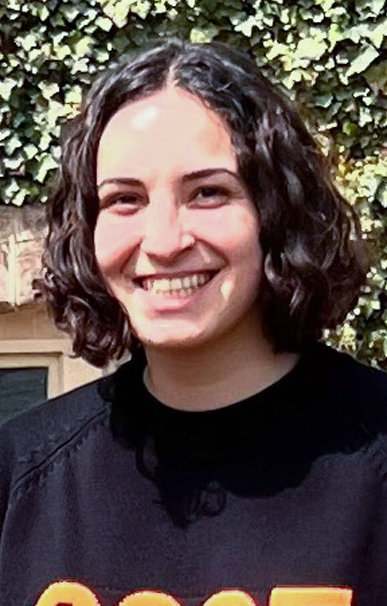 PROJECT
PROJECTMechanism of Shrubification in a Changing Arctic
ORGANIZATION / LOCATIONLevine Lab, Department of Ecology and Evolutionary Biology, Princeton University - Toolik Field Station, Fairbanks, Alaska
MENTOR(S)Jonathan Levine, J.N. Allison Professor in Environmental Studies, Professor of Ecology and Evolutionary Biology; Ruby An, Ph.D. candidate, Ecology and Evolutionary Biology
Certificate(s): Environmental Studies
I observed how different drivers such as warming, nutrient availability and a longer growing season impact shrub expansion or “shrubification“ across the Arctic, focusing on three species: Betula nana (dwarf birch), Salix sp. (dwarf willow) and Alnus viridis (green alder). Other research has observed that these shrubs are expanding across the Arctic, but with no clear explanation for how and why. Understanding the mechanisms of shrubification is critical in understanding how shrubs impact carbon cycling. I tracked the shrubs’ phenological or developmental changes in summer and fall, for example buds breaking, leafing out and senescence. I also helped set up boardwalks for easier access to plots and to limit the destruction of the tundra, and I assisted in taking soil cores to determine how nutrient addition has influenced the composition of the soil. While learning about plants for the first time and learning to identify them was challenging, it was extremely rewarding to look at the tundra at the end of the summer and be able to identify most of the species below me. I have gained an appreciation for the Arctic’s uniqueness as I gained experience in botany, phenological measurements, biogeochemical skills and data analysis.
-
Guest, Tacy ’26
Ecology and Evolutionary Biology
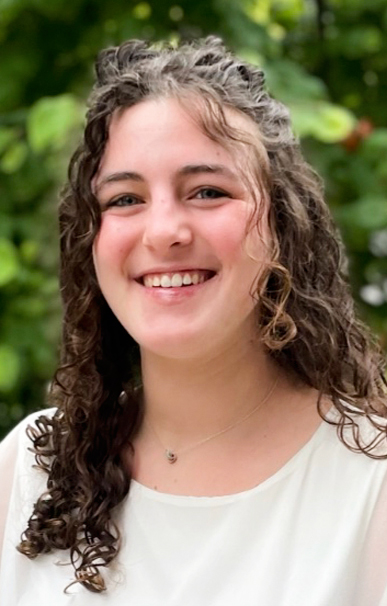 PROJECT
PROJECTInvestigating Nitrogen Allocation in Corals and Their Symbionts
ORGANIZATION / LOCATIONThe Ward Lab, Department of Geosciences, Princeton University - Princeton, New Jersey
MENTOR(S)Bess Ward, William J. Sinclair Professor of Geosciences and the High Meadows Environmental Institute; Moriah Kunes, Ph.D. candidate, Geosciences
Certificate(s): Environmental Studies
I worked with The Ward lab to standardize a method for separating coral tissue from the symbionts that live within the tissue. Coral is composed of coral tissue and single-celled photosynthetic algae symbionts called zooxanthellae. The zooxanthellae undergo photosynthesis and provide energy and fixed carbon to the coral, but little is known about how they contribute to nitrogen uptake. Understanding these relationships is critical to the future preservation of coral species. To understand the nitrogen uptake however, it is necessary to separate the coral tissue and the symbionts. While many methods exist in the literature, there is no standardized method, and the cross contamination between the tissue and the zooxanthellae in existing methods has never been quantified. I tested different variations of the method by preparing samples, assisting in cell counts and running the mass spectrometer, a machine that detects the nitrogen and carbon content of a sample. I also participated in the data analysis that followed these experiments. I practiced technical lab techniques and learned troubleshooting techniques for the mass spectrometer. I’m excited to continue working with The Ward Lab through my sophomore year and on my junior paper and senior thesis.
-
Haarlow, Bill ’25
Geosciences


 PROJECT
PROJECTMetal Isotopes in Ancient Carbonates
ORGANIZATION / LOCATIONHiggins Lab, Department of Geosciences, Princeton University - Princeton, New Jersey
MENTOR(S)John Higgins, Professor of Geosciences; Matthew Nadeau, Ph.D. candidate, Geosciences
I gathered data about various isotopes in ancient carbonates, including lithium, carbon and oxygen, to study how their concentrations changed over time and with ocean depth. These ancient carbonates included limestones and dolomites from around the world, ranging from formations in the United States to the middle of the Pacific Ocean. The carbonate rocks studied may preserve information from ancient surface environments about their local climate and ecosystems and may thus serve as proxy archives of paleoclimate at various times in the ancient past. We used column chromatography and mass spectroscopy to determine the compositions and concentrations of isotopes within the carbonates. The isotopic records for many different elements are incomplete due to the recency of the work. It was awesome to work with people at the cutting edge of the field. Through this internship, I gained experience in experimental design and learned to use common technology used in the field, including automatic ion chromatography machines, ion columns and mass spectroscopy machines. These skills will be useful in my ongoing research projects at Princeton and my future career.
-
Liu, Benjamin ’24
Computer Science
 PROJECT
PROJECTBeyond Roughness: Statistical Characterization of Two-dimensional Fields Under Random Sampling
ORGANIZATION / LOCATIONSimons Research Group, Department of Geosciences, Princeton University - Princeton, New Jersey
MENTOR(S)Frederik Simons, Professor of Geosciences
I explored machine learning methods to estimate and analyze different types of environmental data. Environmental data come as geographically distributed sets of measured or modeled variables, for example rainfall or vegetation type, that we may treat as samples of a spatial random field and its temporal evolution. Random fields are characterized by hyperparameters that define the statistical relationship between their values at different points in space and time. The isotropic Matérn random field is a general class with three continuous parameters that define its spectral structure: variance (σ2), mean-squared differentiability (ν) and correlation length (ρ). Working with Frederik Simons, I developed machine-learning methods to estimate the parameters of random fields. I employed MATLAB and Python programs to generate large sets of training data and developed a convolutional neural network to estimate their parameters. I gained significant experience working with neural networks and non-classification forms of machine learning methods. The project has given me more insight into the research process in the field of machine learning and artificial intelligence as a whole and how to apply these technologies to environmental data.
-
Liu, Isabel ’26
Computer Science
 PROJECT
PROJECTCarbon Dioxide and Hydrogen Storage in Water-saturated Bentonite Clay Systems
ORGANIZATION / LOCATIONInterfacial Water Group, Department of Civil and Environmental Engineering, Princeton University - Princeton, New Jersey
MENTOR(S)Ian Bourg, Associate Professor of Civil and Environmental Engineering and the High Meadows Environmental Institute; Xiaojin Zheng, Postdoctoral Research Associate, Civil and Environmental Engineering
Montmorillonite is a smectite clay mineral that is useful for defining fluid migration pathways and investigating gas storage due to its high swelling pressure and low permeability. In this study, I researched carbon dioxide and hydrogen storage in the subsurface environment, specifically in the interlayer space of montmorillonite that hosts water molecules and hydrated cations. These two gases are stored very differently, but both are important for environmental and industrial reasons; while carbon dioxide is intended to be conserved as long and stably as possible at a depth of more than 800 meters to alleviate global warming, hydrogen is stored at a more superficial level for seasonal injection and removed for industrial purposes. To lay the groundwork for permeability analyses, I used the programs LAMMPS Molecular Dynamics Simulator, Visual Molecular Dynamics and MATLAB to simulate carbon dioxide and hydrogen gas storage in montmorillonite clay at different water saturations. I found it inspiring to be able to use computer simulations to estimate realistic dynamics between molecules and explore this important industrial application at minimal cost. Through this experience, I acquired many technical skills, learned to develop my creativity and gained important insights into geosystems engineering.
-
Machado, Maddie ’25
Ecology and Evolutionary Biology
 PROJECT
PROJECTPlant Pathogens in a High-altitude System
ORGANIZATION / LOCATIONMetcalf Lab, Department of Ecology and Evolutionary Biology, Princeton University - Rocky Mountain Biological Laboratory, Gothic, Colorado
MENTOR(S)C. Jessica E. Metcalf, Associate Professor of Ecology and Evolutionary Biology and Public Affairs, Princeton University; Keenan Duggal, Research Associate, High Meadows Environmental Institute, Princeton University; Juliana Jiranek, Ph.D. candidate, Biology, University of Virginia
Certificate(s): Environmental Studies
I worked as part of a team studying “flax rust,” a fungal infection that affects the flax wildflower in the Gunnison Valley in Colorado. Working in sites across low, middle and high elevations, we conducted repeat surveys in areas between 50 and 200 square meters of plant height, degree of disease infection as determined by the surface area covered by fungal pustules, soil moisture, wind direction, wind speed and several other climatic variables. Ultimately, we hope these data will help predict the dynamics between the flax plant and flax rust, as climate change contributes to hotter and drier conditions in the Gunnison Valley. I enjoyed my time in Gothic at the Rocky Mountain Biological Laboratory because I was exposed to many other research studies happening nearby and was able to collaborate with and learn from other ecologists.
-
Matthews, Aidan ’24
Civil and Environmental Engineering
 PROJECT
PROJECTWater Use Strategy in Plants
ORGANIZATION / LOCATIONPorporato’s Research Group, Department of Civil and Environmental Engineering, Princeton University
MENTOR(S)Amilcare Porporato, Thomas J. Wu ’94 Professor of Civil and Environmental Engineering, Professor of Civil and Environmental Engineering and the High Meadows Environmental Institute, Princeton University; Sara Cerasoli, Ph.D. candidate, Civil and Environmental Engineering, Princeton University; Gabriel Katul, Paul M. Gross Distinguished Professor, Department of Civil and Environmental Engineering, Duke University; Saverio Perri, Visiting Research Scholar, Department of Ecology and Evolutionary Biology, Princeton University
My project examined the theory of optimization in plants. With the support of advisers, particularly Professor Amilcare Porporato, I surveyed and identified gaps in the literature, and attended an ecohydrology graduate school in Italy, where I learned about different areas of ecohydrology. Learning about the impact of plants and water on society expanded my view of the field and its applications. I enjoyed using my knowledge to explore possible explanations for the different strategic responses to water stress and exploring the potential to predict evaporative cooling via an optimization model. This internship has helped cement my passion for research and my decision to continue my studies in a related field through a doctoral degree.
-
Michielssen, Senne ’25
Computer Science
 PROJECT
PROJECTApplication of Image Segmentation to Trezona Formation Fossils
ORGANIZATION / LOCATIONMaloof Research Group, Department of Geosciences, Princeton University - Princeton, New Jersey
MENTOR(S)Adam Maloof, Professor of Geosciences
I studied fossils from the Trezona Formation in Australia with Professor Adam Maloof. We applied computer vision techniques to segment cross-sections of these fossils with the goal of better understanding the 3D structure of these organisms. My contribution to this project involved applying these computer vision techniques to build upon significant lab work that was previously conducted by other members of the Maloof Research Group. The project enhanced my technical and interpersonal skills, which will serve me well in coursework and future research opportunities. I enjoyed the collaborative nature of research and look forward to continuing to explore research at Princeton.
-
Mukherjee, Kaustuv ’26
Operations Research and Financial Engineering
 PROJECT
PROJECTCarbon Dioxide and Hydrogen Storage in Water-saturated Bentonite Clay Systems
ORGANIZATION / LOCATIONMetcalf Lab, Department of Ecology and Evolutionary Biology, Princeton University - Rocky Mountain Biological Laboratory, Gothic, Colorado
MENTOR(S)Ian Bourg, Associate Professor of Civil and Environmental Engineering and the High Meadows Environmental Institute; Xiaojin Zheng, Postdoctoral Research Associate, Civil and Environmental Engineering
Certificate(s): Architecture and Engineering, Finance
I developed molecular dynamics simulations to visualize how bentonite clay would perform as a barrier for supercritical CO2 injected below the Earth’s surface. Studying clay mineralogy and sequestration methods helped enhance my understanding of these simulations. I worked with the Large-scale Atomic/Molecular Massively Parallel Simulator software to run simulations, utilizing Princeton’s Stellar computing cluster to run the larger scripts and the Visual Molecular Dynamics program to visualize the output files. Most of my time was spent using the MATLAB programming language to add CO2 to a bentonite/montmorillonite clay system at different water saturation levels, simulating CO2 sequestration in the porous subsurface. I used the elementary physical model of CO2 due to its agreement with experimental data in our relevant temperature range. The clay-water-CO2 models that I developed can help predict seal integrity over time for large-scale sequestration projects. I enjoyed working with the Interfacial Water Group and found how physics concepts play into developing accurate molecular dynamics simulations especially interesting.
-
Smith, Peyton ’25
Ecology and Evolutionary Biology
 PROJECT
PROJECTPlant Pathogens in a High-altitude System
ORGANIZATION / LOCATIONMetcalf Lab, Department of Ecology and Evolutionary Biology, Princeton University - Rocky Mountain Biological Laboratory, Gothic, Colorado
MENTOR(S)C. Jessica E. Metcalf, Associate Professor of Ecology and Evolutionary Biology and Public Affairs, Princeton University; Keenan Duggal, Research Associate, High Meadows Environmental Institute, Princeton University; Juliana Jiranek, Ph.D. candidate, Biology, University of Virginia
Certificate(s): American Studies
I investigated the effect of elevation on the spread of a fungal pathogen, flax rust (Melampsora lini), on Lewis flax (Linum lewisii), a purple wildflower in the Rocky Mountains. Though this plant pathogen system has been investigated as a model of molecular plant-fungal interactions for decades, little is known about how climate change may affect its spread within and between hosts. We studied the impact of climate on disease by using replicate elevational transects to collect standardized observations and measurements. Each week, we hiked to the transects to survey plants for rust. The data we collected will be used to understand further and model plant-pathogen interactions, which could inform agricultural practices to support food security in the coming decades. In addition to fieldwork, I gained experience using the software R for image analysis and spatial data. I have long been interested in host-pathogen interactions in humans, but this project introduced me to the intricate world of disease ecology and plant pathogens. Consequently, I developed an appreciation for the complicated nature of these coevolved plant-pathogen systems that will frame my future research.
-
Sylvestre, Naisha ’25
Molecular Biology
 PROJECT
PROJECTMetal Isotopes in Ancient Carbonates
ORGANIZATION / LOCATIONHiggins Lab, Department of Geosciences, Princeton University - Princeton, New Jersey
MENTOR(S)John Higgins, Professor of Geosciences; Matthew Nadeau, Ph.D. candidate, Geosciences
Certificate(s): Global Health and Health Policy, Latin American Studies
My project’s objective was to gather data on the isotopic carbon and oxygen content of ancient carbonate samples across time and ocean depth. This isotopic data will allow us to infer whether differences in sample composition are due to local processes of rock formation or more indicative of global paleoclimate. The carbonate rocks studied may preserve information from ancient surface environments about their local climate and ecosystems, and thus may serve as proxy archives of paleoclimate at various times in the ancient past. I analyzed ancient carbonate samples from a region in the Pacific Ocean by first using imaging techniques to identify each sample’s composition and then performing mass spectroscopy to determine isotopic composition and concentration. Using isotopic records in this manner is somewhat new in the field, and I enjoyed getting to work with people at the cutting edge of paleoclimate research. I learned many lab skills including experimental design and how to operate seminal technology such as automatic ion chromatography and mass spectroscopy machines. I will utilize the skills I developed in my junior independent work, senior thesis and beyond Princeton.
-
Szostak, Stella ’26
Geosciences
 PROJECT
PROJECTThe Coevolution of Life and Climate Over 800 Million Years (in Australia)
ORGANIZATION / LOCATIONMaloof Research Group, Department of Geosciences, Princeton University - Adelaide, Australia; Princeton, New Jersey
MENTOR(S)Adam Maloof, Professor of Geosciences; Ryan Manzuk, Ph.D. candidate, Geosciences; Julia Wilcots, Postdoctoral Research Associate, Geosciences
I investigated the coevolution of life and climate in Australia during two periods: Snowball Earth and the Cambrian Explosion. Snowball Earth describes two events when the Earth became completely glaciated during the Neoproterozoic era, between 720 and 635 million years ago. The Cambrian Explosion, when animals rapidly evolved into the major groups we recognize today, occurred 100 million years later. In the field, we studied and measured layers of carbonate sedimentary rock from the Neoproterozoic to make interpretations of the paleoenvironment. Beyond making these observations, I took GPS points, collected and labeled samples and measured rock layers. To study the Cambrian era, we measured, mapped and sampled a fossilized reef to understand how reef environments impact rapid evolution. Back on campus, I sorted, sawed and polished the Neoproterozoic samples for imaging and analysis while running the mass spectrometer. Participating in the process from field to lab forced me to view geology in a new sense. I began to recognize the sheer amount of information that can be read from the rocks; from observations in a bedded layer to data out of a mass spectrometer. After deep-diving into sedimentary geology, I look forward to exploring even more possibilities within geoscience.
-
Yoo , Erin ’26
Geosciences
 PROJECT
PROJECTGround-truthing Nitrogen Isotopes in Celtis (Hackberry) Endocarps as a Paleoclimate Proxy
ORGANIZATION / LOCATIONSigman Research Laboratory, Department of Geosciences, Princeton University - Princeton, New Jersey
MENTOR(S)Daniel Sigman, Dusenbury Professor of Geological and Geophysical Sciences, Professor of Geosciences; Mason Scher, Ph.D. candidate, Geosciences
Hackberry trees are a deciduous group that have had widespread distribution across the Americas and Mediterranean since at least the Paleocene epoch (56-66 million years ago). Hackberry trees are a useful model for reconstructing the historical climate because of the structure of their endocarps, a hard layer of the seed. Hackberry endocarps are made of calcium carbonate, a mineral commonly used to reconstruct the historical climate, and they also trap organic matter as they form. My project examined the potential for using the isotopic nitrogen composition of Hackberry endocarps as a paleoclimate proxy. I measured the nitrogen isotopic composition of modern U.S. hackberries and analyzed their composition in relation to mean annual temperature and precipitation. I found that high δ15N endocarp values correlated with hotter and drier sample regions, indicating that fossil hackberries have promising potential to be paleoclimate proxies. Climate reconstructions based on hackberries could provide insight into modern-day global warming. Through my internship, I learned how to use new lab equipment, including a sonicator, aspirator, muffle oven and mass spectrometer. I realized that I love pipetting to a surprising degree. I enjoyed learning about the natural world and I plan to continue studying geosciences at Princeton.
- Environment and Society and Urban Sustainability
-
Blohm, Emeline ’25
Civil and Environmental Engineering
 PROJECT
PROJECTModeling Tree Rainfall Interception Through Open Data Analysis
ORGANIZATION / LOCATIONUrban Modeling Group, Tandon School of Engineering, New York University (NYU) - Brooklyn, New York
MENTOR(S)Debra Laefer, Professor of Urban Informatics, Tandon School of Engineering, NYU
I developed an original methodology to estimate the rainfall interception and storage capacity of 98,700 trees in Brooklyn, New York. Urban flood models often neglect tree canopy as a form of green infrastructure mitigation, but trees mitigate pluvial flooding by intercepting and storing rainfall. The quantity of rain mitigated by an individual tree depends on characteristics such as species, diameter, height and canopy area. For large areas with diverse tree types, remote sensing datasets can be used to estimate these features. I gathered tree features for 20.25 km2 of Brooklyn from two open datasets. I processed these datasets and calculated the bark and leaf storage per block based on values aggregated from peer-reviewed literature. In the application QGIS, I visualized the distribution of tree canopy and bark and leaf rainfall storage per block and total storage per square meter of canopy. I used the storage values in an existing model and found that for the study area, the total tree storage is over 1.7 million liters of rain. I also found that the bark surface intercepts more water than the leaf surface (77.5% vs. 22.5%). These results can be integrated into flood models to evaluate the impact of tree cover on pluvial flooding.
-
Doyle, Billy ’24
School of Public and International Affairs
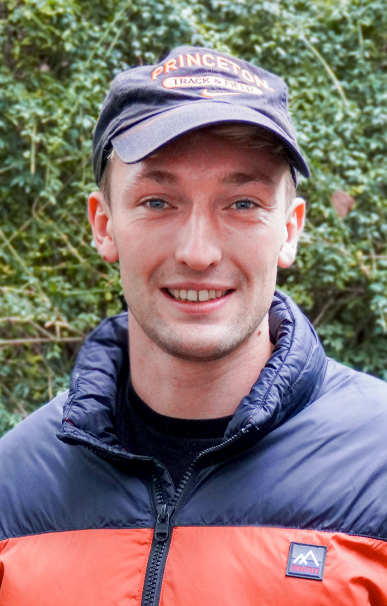 PROJECT
PROJECTThe Social-ecological Dynamics of the Harvest, Consumption and Trade of Aquatic Biodiversity in New York City
ORGANIZATION / LOCATIONHigh Meadows Environmental Institute, Princeton University; American Museum of Natural History; New York City Department of Parks and Recreation (NYC Parks) - New York City, New York; Princeton, New Jersey
MENTOR(S)Christian Rivera, Postdoctoral Research Associate, High Meadows Environmental Institute, Princeton University; Erin Betley, Biodiversity Specialist and Coordinator, American Museum of Natural History; Mary Blair, Director, Biodiversity Informatics Research, American Museum of Natural History; Neha Savant, Wildlife and Fisheries Ecologist, NYC Parks
Certificate(s): German Language and Culture
I helped conduct a pilot study on the trade, harvest and consumption of marine wildlife caught within New York City waters. The project involved fieldwork at multiple sites around the city, interviews with a variety of experts in academia, activists and other professionals. I also performed a thorough literature search, drafted a report and presented my findings to a working group from a variety of organizations. Through this internship, I learned what research looks like at a professional level. I gained first-hand experience in conducting research, how to investigate and adapt to a project on a topic I knew little about and how to effectively communicate findings in a professional setting.
-
Gomes, Isabella ’25
Civil and Environmental Engineering
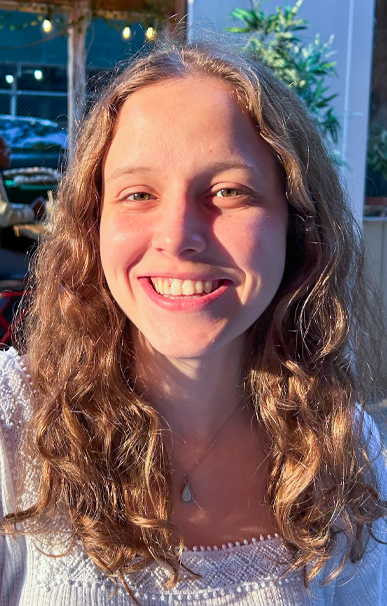 PROJECT
PROJECTFine Spatio-temporal Variation in Intra-urban Heat Stress in U.S. Cities
ORGANIZATION / LOCATIONUrban Nexus Lab, Department of Civil and Environmental Engineering, Princeton University - Princeton, New Jersey; Minneapolis, Minnesota
MENTOR(S)Anu Ramaswami, Sanjay Swani ’87 Professor of India Studies, Professor of Civil and Environmental Engineering, Princeton Institute for International and Regional Studies and the High Meadows Environmental Institute
Certificate(s): Urban Studies
The Urban Nexus Lab aims to advance sustainable, healthy and equitable cities through knowledge co-production and nexus modeling of key transboundary infrastructure and food systems. I worked on a project that is assessing fine-scale temperature and humidity data to study variations in intra-urban heat stress in different cities in the United States. My role was to analyze fine-scale air temperature and humidity data downloaded from PurpleAir, a crowdsourced sensor network. Along with data analysis for different U.S. cities, I worked on downloading land surface temperature data from Google Earth Engine to aid the lab’s work on comparing the accuracy of air and land surface temperature observations for determining human heat stress. I hope to continue researching sustainable development and the impacts of climate change on the urban environment.
-
Hanson, Samuel ’24
Music
 PROJECT
PROJECTReligion and Environmental Justice in Panama and the Peruvian Amazon
ORGANIZATION / LOCATIONHigh Meadows Environmental Institute, Princeton University; Paz y Esperanza Perú - Princeton, New Jersey; San Martin, Perú
MENTOR(S)Rob Nixon, Thomas A. and Currie C. Barron Family Professor in Humanities and the Environment, Professor of English and the High Meadows Environmental Institute; Ryan Juskus, Postdoctoral Research Associate, High Meadows Environmental Institute
Our project aimed to explore the link between religion — both colonial and indigenous— and the environment in Panama and the Peruvian Amazon. During our two-week stay in Moyobamba, Perú, we interviewed members of Paz y Esperanza, a faith-based organization, and other members of the community, asking questions about why they are motivated to fight for environmental justice. The work we did opened my eyes to the reality of modernity and the forces driving the extraction of resources from the Amazon rainforest. It also gave me perspective on the types of lifestyles that are causing suffering. For instance, visiting a nearby rainforest preserve gave me a very different taste of life compared to the busy town I stayed in. I also gained insight into the knowledge that Indigenous people have of the cycles of life and the relationship between humans and non-humans. I have come to appreciate that this knowledge is something that we need to reconnect with in order to reintegrate our way of being with the natural order. We are all indigenous someplace on the earth, but at the same time, we seem to have forgotten our true connection.
-
Kotta, Sriya ’26
Civil and Environmental Engineering
 PROJECT
PROJECTFine Spatio-temporal Variation in Intra-urban Heat Stress in U.S. Cities; Relevance of Polluting Fuel Used in Informal Eateries in Indian Cities
ORGANIZATION / LOCATIONUrban Nexus Lab, Department of Civil and Environmental Engineering, Princeton University - Princeton, New Jersey; Minneapolis, Minnesota
MENTOR(S)Anu Ramaswami, Sanjay Swani ’87 Professor of India Studies, Professor of Civil and Environmental Engineering, Princeton Institute for International and Regional Studies and the High Meadows Environmental Institute
I worked on two projects within the Urban Nexus Lab, whose overall goal is to advance sustainable, healthy and equitable cities through knowledge co-production and nexus modeling of key transboundary infrastructure and food systems. In the first project, I investigated intra-urban heat stress by analyzing data from PurpleAir sensors in Minneapolis. During a field trip to the city, I visited several sensor sites in order to calibrate the PurpleAir sensors with other sensors used in the lab. We discovered that the sensors need a new correction factor and are now working to develop this. We also devised a methodology for fine-scale heat stress measurement in other cities. In the second project, I studied emissions from the informal food sector in Surat, Gujarat. This often-overlooked sector may contribute significantly to the country’s emissions and air pollution. To quantify this, I compared the informal food sector, household cooking and other industries by analyzing national datasets like the Socio Economic and Caste Census and the Economic Census datasets. Working with the Urban Nexus Lab was an enriching experience as it allowed me to connect with exceptional researchers and professionals and gain valuable insights into urban sustainability.
-
Norbrook, Alex ’26
History
 PROJECT
PROJECTMining for the Climate
ORGANIZATION / LOCATIONBlue Lab, Effron Center for the Study of America, Princeton University - Pasadena, California; Thacker Pass, Nevada; Princeton, New Jersey; Gaston County, North Carolina
MENTOR(S)Allison Carruth, Professor of American Studies and the High Meadows Environmental Institute, Princeton University; Nate Otjen, Postdoctoral Research Associate, High Meadows Environmental Institute, Princeton University; Juan Manuel Rubio, UC President’s and Andrew W. Mellon Postdoctoral Fellow, Department of Global Studies, University of California, Santa Barbara
Certificate(s): Environmental Studies
The net-zero transition will be fueled by mineral extraction. The Biden administration and climate policy experts aim to expand domestic extraction of critical minerals to rapidly deploy electric vehicles and combat transportation emissions. Mining companies are moving forward with new projects in states like Nevada, North Carolina and California. Because narratives around climate mitigation are usually crafted and disseminated at a distance from those directly affected by mining activity, I wanted to examine how they are deployed and experienced on the ground. I aimed to address questions including, how do mining companies use net-zero narratives to justify their projects, and how do residents and activists counter them while opening alternate paths to a climate-safe future? I conducted 10 days of fieldwork at two proposed mine locations to contribute to a podcast on critical mineral narratives. I learned to conduct in-depth interviews and deploy audio equipment and then worked to craft a five-part audio series on one mine in North Carolina. I used podcast editing software to draft the third episode, which focuses on the logistics of the mine. I now have a clearer understanding of why an environmental justice approach is necessary for a successful energy transition.
-
Nuermberger, Charlie ’25
Comparative Literature
 PROJECT
PROJECTIdentifying Advocacy Opportunities for a Basin-scale Approach to Natural Infrastructure
ORGANIZATION / LOCATIONEnvironmental Defense Fund (EDF) - Raleigh, North Carolina
MENTOR(S)Will McDow, Director, Climate Resilient Coasts and Watersheds, EDF
Certificate(s): Environmental Studies
Because the biophysical boundaries of a watershed like the Mississippi River basin don’t correlate well with political units like the municipality, county or state, the Environmental Defense Fund (EDF) advocates for a “whole river” or basin-scale approach to improving water resource conditions in major watersheds. Two central challenges for producing change at this scale are modeling project benefits and accessing appropriate funding mechanisms for project implementation. I worked with EDF to develop an agenda and produce a summary report about a workshop entitled “Quantifying the Downstream Benefits of Natural Infrastructure” that convened to discuss modeling opportunities in the basin. I also drafted briefs on state-level policy for the Clean Water State Revolving Fund to identify changes that could enable better access to funds. I practiced skills like workshop facilitation, technical writing and policy research. My experience highlighted the importance of informational collaboration and careful maneuvering through existing economic structures.
-
Rivera-Janer, Isadora ’24
Ecology and Evolutionary Biology
 PROJECT
PROJECTThe Social-ecological Dynamics of the Harvest, Consumption and Trade of Aquatic Biodiversity in New York City
ORGANIZATION / LOCATIONHigh Meadows Environmental Institute, Princeton University; American Museum of Natural History; New York City Department of Parks and Recreation (NYC Parks) - New York City, New York; Princeton, New Jersey
MENTOR(S)Christian Rivera, Postdoctoral Research Associate, High Meadows Environmental Institute, Princeton University; Erin Betley, Biodiversity Specialist and Coordinator, American Museum of Natural History; Mary Blair, Director, Biodiversity Informatics Research, American Museum of Natural History; Neha Savant, Wildlife and Fisheries Ecologist, NYC Parks
Certificate(s): Environmental Studies
I helped conduct a preliminary study of the harvest, trade and consumption of aquatic wildlife in New York City (NYC). Our methods included field visits to fish markets and coastal sites in NYC, interviews with stakeholders from various fields and reviews of relevant academic literature. After synthesizing information from these sources, we then used the Mental Modeler software to create models that attempt to represent the trade systems of NYC and Jamaica Bay. We found relationships between many factors including fish advisories, law enforcement, inflation, targeted wildlife populations and climate change. Overall, we found many research gaps in the knowledge of wildlife trade systems in NYC in terms of ecological, cultural, legal and social aspects. This project gave me a rare glimpse into how to create methods for data collection, even when working with unfamiliar systems.
-
Rodriguez, Jamie ’24
English
 PROJECT
PROJECTArchival Ecologies
ORGANIZATION / LOCATIONBlue Lab, Effron Center for the Study of America, Princeton University - Lytton, British Columbia, Canada; Princeton, New Jersey
MENTOR(S)Allison Carruth, Professor of American Studies and the High Meadows Environmental Institute; Jayme Collins, Postdoctoral Research Associate, High Meadows Environmental Institute
I worked to develop a podcast called “Archival Ecologies” that explores the changing meaning of archives in Lytton, British Columbia, following a fire that leveled the town in 2021. In the podcast, our definition of archives included not only local museums but also personal collections and the natural environment. I conducted research that helped guide the podcast’s storyline and then traveled to British Columbia with the podcast team to interview caretakers of local archives and individuals who experienced the fire. When we returned to campus, I helped write and record a draft of the podcast’s first episode. My time as an intern for “Archival Ecologies” introduced me to a form of research that bridges my interests in humanities research and audio storytelling.
-
Shin, Hannah ’26
Philosophy
 PROJECT
PROJECTReligion and Environmental Justice in Panama and the Peruvian Amazon
ORGANIZATION / LOCATIONHigh Meadows Environmental Institute, Princeton University; Memoria Indigena Pamana; Paz y Esperanza Perú - Princeton, New Jersey; Guna Yala, Panama; San Martín, Perú
MENTOR(S)Rob Nixon, Thomas A. and Currie C. Barron Family Professor in Humanities and the Environment, Professor of English and the High Meadows Environmental Institute; Ryan Juskus, Postdoctoral Research Associate, High Meadows Environmental Institute
Certificate(s): Computer Science
I explored the landscape of indigenous environmental justice in Latin America and how religion interacts with environmental commitments. My team’s approach was non-extractive and rooted in decolonization as we collaborated and communicated across diverse knowledge systems. I visited two islands in Guna Yala, Panama, and met evangelical Christian Guna, who maintain their indigenous worldviews. I learned how they navigate their seemingly incongruous identities and beliefs. I wrote a report about environmental issues on the islands, the relationship between Guna Yala and the Panamanian government, and the climate change-driven migration to Panama’s mainland. The Guna hope to relocate but have no plan, insufficient funds and empty promises of support from the Panamanian government. In Perú, I visited Indigenous communities and interviewed religious members and government ministers about deforestation, conflicting interests and corruption. I contributed to a pronouncement about illegal gold mining in the Cenepa River region, which will be circulated to demand that the Peruvian government protect and support Indigenous communities. I observed the ethics of the environmental defenders and examined what moves them to do what they do despite dangers and death threats. I observed that while there is vulnerability in these communities, there is also great resistance.
-
Taylor, Molly ’25
History
 PROJECT
PROJECTArchival Ecologies
ORGANIZATION / LOCATIONBlue Lab, Effron Center for the Study of America, Princeton University - Lytton, British Columbia, Canada; Princeton, New Jersey
MENTOR(S)Allison Carruth, Professor of American Studies and the High Meadows Environmental Institute; Jayme Collins, Postdoctoral Research Associate, High Meadows Environmental Institute
Certificate(s): Computer Science
As climate change increases the frequency of extreme weather events, museums and archives are increasingly at risk of damage and destruction. I contributed research and writing to an audio series about the collections lost in the 2021 wildfire in Lytton, British Columbia. Through the story of Lytton, this project explores the connection between climate change and cultural preservation. Our team spent a week in British Columbia interviewing the stewards of Lytton’s cultural institutions about their collections and plans for recovery. Participating in fieldwork strengthened my interest in the environmental humanities and expanded the possibilities for my independent work as a history major. In the final weeks of the internship, we produced the first episode of the series. This work reinforced my excitement for nonfiction storytelling, as I loved thinking creatively to present interviewees’ perspectives alongside historical context. Beyond the concrete skills I developed during this internship, which included writing for audio, recording high-quality audio and finding obscure sources through the library, I gained an understanding of how to tell nuanced, personal stories around climate change.
-
Wang, Grace ’26
Undeclared
 PROJECT
PROJECTMining for the Climate
ORGANIZATION / LOCATIONBlue Lab, Effron Center for the Study of America, Princeton University - Pasadena, California; Thacker Pass, Nevada; Princeton, New Jersey; Gaston County, North Carolina
MENTOR(S)Allison Carruth, Professor of American Studies and the High Meadows Environmental Institute, Princeton University; Nate Otjen, Postdoctoral Research Associate, High Meadows Environmental Institute, Princeton University; Juan Manuel Rubio, UC President’s and Andrew W. Mellon Postdoctoral Fellow, Department of Global Studies, University of California, Santa Barbara
I worked with the Blue Lab’s Mining for the Climate team to research lithium mining in the United States and produce a public-facing podcast series about a proposed lithium mine in Gaston County, North Carolina. Following preliminary research, our team undertook 10-days of fieldwork in North Carolina, California and Nevada. We traveled to proposed mine sites and interviewed mining company executives, local activists and government officials. During our fieldwork, we reckoned with the challenges posed by the renewable energy transition and the consequences of the extractive processes necessary for it. After returning, we workshopped our podcast’s first season and began writing the episodes. I spearheaded production on the fourth episode in the series, which delves into the narratives of local residents in Gaston County. During this internship, I gained valuable fieldwork research and audio production skills, as well as expansive knowledge of the complex issues surrounding energy transition and extraction.
-
Weaver, Lily ’26
Computer Science


 PROJECT
PROJECTFine Spatio-temporal Variation in Intra-urban Heat Stress in U.S. Cities
ORGANIZATION / LOCATIONUrban Nexus Lab, Department of Civil and Environmental Engineering, Princeton University - Princeton, New Jersey
MENTOR(S)Anu Ramaswami, Sanjay Swani ’87 Professor of India Studies, Professor of Civil and Environmental Engineering, Princeton Institute for International and Regional Studies and the High Meadows Environmental Institute
Certificate(s): Engineering Biology, Statistics and Machine Learning
The Urban Nexus Lab aims to advance sustainable, healthy and equitable cities through knowledge co-production and nexus modeling of key transboundary infrastructure and food systems. I worked on a project to examine intra-urban heat stress patterns in various U.S. cities. I created a data download tool to access temperature and humidity data from PurpleAir, a crowdsourced sensor network that collects air quality data. I also worked on analyzing and creating visualizations for the PurpleAir data to help us determine the viability of PurpleAir sensors to measure fine-scale intra-urban temperature variation. I’m grateful I had the opportunity to learn from the outstanding professors and graduate students at the Urban Nexus Lab and I hope to continue researching urban sustainability in the future.
-
Widmann, Max ’24
History
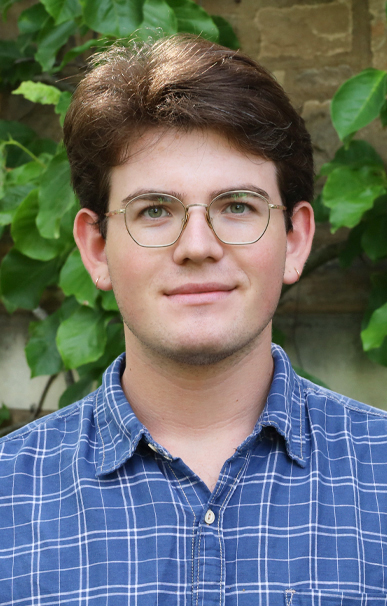 PROJECT
PROJECTMining for the Climate
ORGANIZATION / LOCATIONBlue Lab, Effron Center for the Study of America, Princeton University - Pasadena, California; Thacker Pass, Nevada; Princeton, New Jersey; Gaston County, North Carolina
MENTOR(S)Allison Carruth, Professor of American Studies and the High Meadows Environmental Institute, Princeton University; Nate Otjen, Postdoctoral Research Associate, High Meadows Environmental Institute, Princeton University; Juan Manuel Rubio, UC President’s and Andrew W. Mellon Postdoctoral Fellow, Department of Global Studies, University of California, Santa Barbara
Certificate(s): Environmental Studies, Urban Studies
I researched lithium extraction in the United States. Lithium is an alkali metal essential for most electric vehicle batteries and grid-scale energy storage, but its mining is damaging and irreversible. I wanted to understand the competing narratives behind the green energy transition and inherently unsustainable extractive systems. Working with my co-interns and postdoctoral researchers in Princeton’s Blue Lab, I compiled an archive of statements from government agencies and mining corporations and secondary literature from environmental studies and the energy humanities. Additionally, I worked to identify potential stakeholders to interview, including environmental activists, mining corporation executives, affected Native American tribes, and ranchers. I participated in fieldwork in Gaston County, North Carolina; Pasadena, California; and northern Nevada. There, I conducted semi-structured interviews about residents’ experiences living near planned lithium mines. The first season of our podcast, “Mining for the Climate,” focuses on a junior mining company whose project, Carolina Lithium, has raised concerns among locals about noise, dust, water contamination and the future of their rural community. Working with the Blue Lab, interacting with environmental activists, and observing the insufficiency of environmental legislation has reaffirmed my desire to pursue a career that protects biodiversity and equitable access to federal lands.
- Food Systems and Health
-
Beers, Brooke ’25
Civil and Environmental Engineering
 PROJECT
PROJECTFarm Project Field Assistant
ORGANIZATION / LOCATIONRubenstein Lab, Department of Ecology and Evolutionary Biology, Princeton University - Princeton, New Jersey
MENTOR(S)Daniel Rubenstein, Class of 1877 Professor of Zoology, Emeritus, Professor of Ecology and Evolutionary Biology, Emeritus; Gina Talt, Project Manager, Food Systems, Office of Sustainability
Certificate(s): Sustainable Energy
I worked on the Three Sisters Project through the Rubenstein Lab to study the mutualisms of maize, beans and squash. Our goal was to experimentally test whether growing these three plants together helps crop efficiency and soil health. I was involved with setting up and starting data collection for the project, which is still ongoing throughout the fall. I was also tasked with managing the irrigation system, a combination of drip tape and piping that spanned four fields. I learned more about sustainable farming practices, some hands-on skills with tools and the basics of data collection and analysis through JMP software. I was most interested in the challenges of conducting research in an agricultural setting, where conditions are difficult to control. This internship sparked my interest in increasing agricultural efficiency sustainably, and I’m now interested in potentially pursuing a career in that direction.
-
Charania, Riyan ’26
Computer Science
 PROJECT
PROJECTFarm Project Field Assistant
ORGANIZATION / LOCATIONRubenstein Lab, Department of Ecology and Evolutionary Biology, Princeton University - Princeton, New Jersey
MENTOR(S)Daniel Rubenstein, Class of 1877 Professor of Zoology, Emeritus, Professor of Ecology and Evolutionary Biology, Emeritus; Gina Talt, Project Manager, Food Systems, Office of Sustainability
Due to an increasing global demand for food, it’s important that we have more productive and environmentally friendly growing methods. To address this, we researched the “three sisters” Native American agricultural growing technique, which utilizes mutualisms between corn, beans and squash to maximize their productivity. We tested different designs of growing these crops and analyzed each configuration by collecting field data through Arable sensors. These sensors provided information about factors such as plant health, environmental temperature and precipitation. We also collected data by setting up insect traps, collecting soil moisture data and taking drone photos of the field. We then used the statistical analysis software JMP to graph and analyze the data for insights into the potential benefits of using the three sisters farming method. Through this internship, I learned just how technology can be integrated into agriculture, and I hope to continue finding innovative ways to use technology to create a more sustainable future.
-
Evangelista, Sava ’26
Computer Science
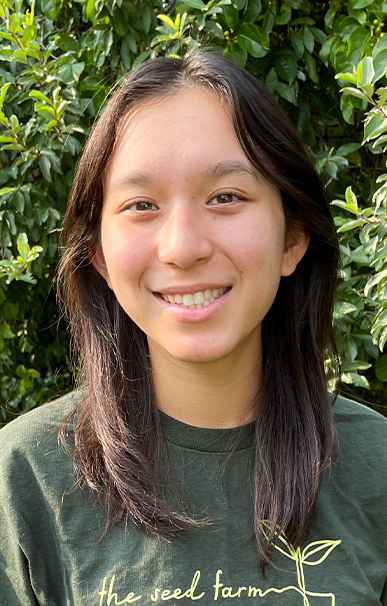 PROJECT
PROJECTProbing Microbial Colonization of Plants During Drought to Enable Microbiome-mediated Resilience in Crops
ORGANIZATION / LOCATIONConway Lab, Department of Chemical and Biological Engineering, Princeton University - Princeton, New Jersey
MENTOR(S)Jonathan Conway, Assistant Professor of Chemical and Biological Engineering; Ting Jiang, Postdoctoral Research Associate, Chemical and Biological Engineering; Chao Liao, Postdoctoral Research Associate, Chemical and Biological Engineering
The primary goal of my project was to grow plants in a simulated drought environment and to analyze their root microbiomes. This data will enable us to identify which bacterial strains become enriched during drought and study them in hopes of creating techniques that would allow plants to survive better in drought conditions. I helped prepare farmland for the high tunnel used for the research and participated in many other projects at the Stony Ford Seed Farm. Additionally, I assisted postdoctoral researchers with their gene knockout experiments, took root measurements and imaged seedlings. Through this project and with the guidance of my mentors, I have gained a lot of lab experience and more general science knowledge and I was especially interested to observe the amount of meticulosity that goes into each step of an experiment. Although I don’t think I will pursue work in the chemical and biological engineering field, the internship was helpful in providing me with a further understanding of the sciences.
* This internship is connected to the HMEI Water and the Environment Grand Challenges project, “Probing Microbial Colonization of Plants During Drought to Enable Microbiome-Mediated Resilience in Crops.”
-
Ficco, Kaeli ’24
Chemical and Biological Engineering
 PROJECT
PROJECTProbing Suppression and Evasion of the Plant Immune System by Commensals From the Plant Root Microbiome
ORGANIZATION / LOCATIONConway Lab, Department of Chemical and Biological Engineering, Princeton University - Princeton, New Jersey
MENTOR(S)Jonathan Conway, Assistant Professor of Chemical and Biological Engineering; Samuel Eastman, Postdoctoral Research Associate, Chemical and Biological Engineering
I studied how root commensal bacteria can suppress the plant immune system to enable these bacteria to cohabitate with the plant. Specifically, I investigated a group of bacteria that share a similar protein that cuts an immune-triggering microbe-associated molecular pattern. I was tasked with deleting these genes and using various assays to quantitatively and qualitatively classify immune suppression of my gene deletion strains compared to the wild-type bacteria. Throughout the internship, I utilized and developed multiple lab procedures including cloning, DNA and protein expression techniques, protein separation techniques and techniques to identify plant immune activation. I also learned valuable scientific presentation and writing skills that I look forward to utilizing as I continue my research in the Conway Lab next year.
-
Gregory, Alliyah ’25
Ecology and Evolutionary Biology
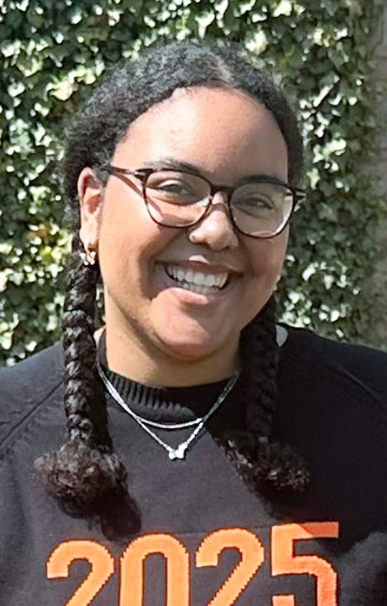 PROJECT
PROJECTExploring Natural Variation of Seed Oil Content in Okra (Abelmoschus esculentus) for Climate-resilient Agriculture
ORGANIZATION / LOCATIONConway Lab, Department of Chemical and Biological Engineering, Princeton University - Princeton, New Jersey
MENTOR(S)Jonathan Conway, Assistant Professor of Chemical and Biological Engineering
Certificate(s): Environmental Studies, Latin American Studies
I worked with Princeton University’s Conway Lab at the Stony Ford Seed Farm and in the laboratory on various projects related to climate-resilient agriculture. For the okra project, we grew different varieties of okra as a practice for adapting agricultural processes in the face of climate change. Since okra is resilient to climate change, the goal is to examine the oil content of okra seeds as a sustainable cooking oil. For the drought project, we grew corn, sorghum, canola, soybean and oats under drought and well-watered conditions to compare interactions between plant roots and the microbiome under different water conditions. The ultimate goal of this project is to identify bacteria that help the plants survive during drought. At the Seed Farm, my primary duties were tending to the plants (watering, weeding, etc.) and ensuring that everything was in order. In the lab, I aided the postdoctoral researchers in their projects and performed general lab duties. I learned a lot about agriculture and biology in general during this internship, and I hope to combine lab and field work in my future career.
-
Henyo, Kelih ’26
Undeclared
 PROJECT
PROJECTHealth and Conservation at the Human-Domestic Animal-Wildlife Interface in Madagascar
ORGANIZATION / LOCATIONMetcalf Lab, Department of Ecology and Evolutionary Biology, Princeton University - Antananarivo, Madagascar; Betampona Natural Reserve, Madagascar
MENTOR(S)C. Jessica E. Metcalf, Associate Professor of Ecology and Evolutionary Biology and Public Affairs, Princeton University; Fidisoa Rasambainarivo, Postdoctoral Research Associate, High Meadows Environmental Institute, Princeton University
I studied the interplay of environmental, wildlife and domestic animal health on the health of people in Madagascar under the “One Health” framework. Our team tested for pathogens including Bartonella, Babesia and Leptospira, and I specifically focused on Toxoplasma gondii, a foodborne and zoonotic parasite that infects roughly one in every three people globally. I aimed to map out the disease ecology of this parasite. To do this, I used sentinel rats and chickens to ascertain its prevalence in the environment at the Betampona Natural Reserve and its surrounding communities, investigated its prevalence amongst Madagascar’s native wildlife species including lemurs and carnivores and explored possible connections and eradication strategies amongst the wildlife in Madagascar. Combining ecological fieldwork and molecular biology lab work in DNA extractions and polymerase chain reaction, I sought to understand the whole organism niche level of this parasite by profiling its presence in tissue samples collected from both lemurs and carnivores. From this research experience, I’ve gained a deeper appreciation for how all of life is intertwined in one collective fate and the many different angles scientific inquiry can take. I’m keen to continue studying toxoplasmosis and other diseases in the future.
* This internship is connected to the HMEI Biodiversity Grand Challenges project, “Biodiversity Conservation and Health at the Human-Domestic Animal-Wildlife Interface in Madagascar.”
-
Iwasaki, Noe ’26
Undeclared
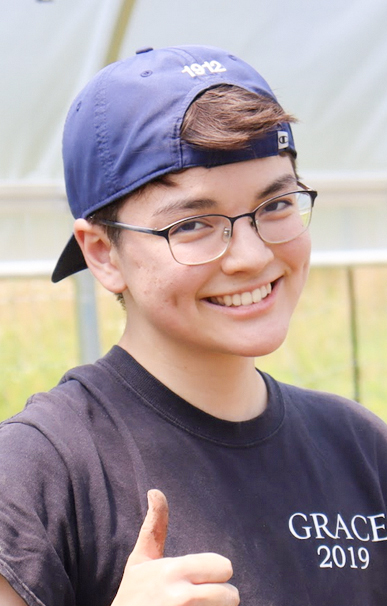 PROJECT
PROJECTExploring Natural Variation of Seed Oil Content in Okra (Abelmoschus esculentus) for Climate-resilient Agriculture
ORGANIZATION / LOCATIONConway Lab, Department of Chemical and Biological Engineering, Princeton University - Princeton, New Jersey
MENTOR(S)Jonathan Conway, Assistant Professor of Chemical and Biological Engineering
Okra is extremely drought tolerant and grows in hot climates; thus, it would be a suitable crop for adapting to a changing climate and higher global temperatures. It also yields a large amount of oil per hectare and could be used as a market-viable cooking oil. I worked at the Stony Ford Seed Farm to grow okra plants in preparation for further research that will measure and characterize okra seed oil. The information gleaned from this study will inform future efforts to selectively breed okra varieties for greater seed oil content. Our team planted approximately 2,000 genetically distinct okra plants at the Seed Farm. I assisted in weeding, pruning and individually labeling each okra plant. I also bagged the okra flowers to ensure that the okra were self-pollinated and not crossed with other okra varieties. Though my focus was on the okra project, I also had the opportunity to work with other researchers at the Seed Farm on their projects. Through my experience, I learned a great deal about environmentally friendly farming practices and the work it takes to sustain a farm.
-
Meng, Claire ’26
Civil and Environmental Engineering
 PROJECT
PROJECTUnderstanding the Air Quality and Health Impacts from Increasing U.S. Wildfires
ORGANIZATION / LOCATIONMauzerall Group, Center for Policy Research on Energy and the Environment (C-PREE), School of Public and International Affairs, Princeton University - Princeton, New Jersey
MENTOR(S)Denise Mauzerall, William S. Tod Professor of Civil and Environmental Engineering and Public and International Affairs; Yuanyu Xie, Associate Research Scholar, School of Public and International Affairs
Wildfires are burning longer and occurring more frequently, and their adverse health effects are becoming more prominent. While increasing studies are analyzing the health effects of wildfire smoke particulate matter that are 2.5 microns or smaller in diameter (PM2.5), few studies have investigated this particulate matter over longer time frames and in specific geographic areas. Thus, our project examined wildfire smoke PM2.5 in the United States from 1990-2020 at the county level, using asthma as the main indicator of health. As previous studies have cited the lack of county-specific databases as a reason for taking a broader-level approach, I worked to compile data from various state and county sources to create comprehensive datasets on asthma-related hospitalization and emergency department visits. I also analyzed the data by creating time series charts and maps in the program R. From this experience, I gained invaluable knowledge in creating research proposals and experience in the highly detailed work required to produce practical results. Additionally, it opened my eyes to the breadth of possibilities in the research world, and especially in environmental research.
-
Nguyen, Chien ’25
Computer Science
 PROJECT
PROJECTDistribution of Air Pollution in India
ORGANIZATION / LOCATIONMauzerall Group, Center for Policy Research on Energy and the Environment (C-PREE), School of Public and International Affairs, Princeton University - Princeton, New Jersey
MENTOR(S)Denise Mauzerall, William S. Tod Professor of Civil and Environmental Engineering and Public and International Affairs; Yuanyu Xie, Associate Research Scholar, School of Public and International Affairs
Certificate(s): Applied and Computational Mathematics, Statistics and Machine Learning
I worked with the Mauzerall Group to understand the distribution of air pollution in India and how air pollution policies impact the air quality and greenhouse gas emissions in India. For example, how the switch from coal-fired power generation to greener sources of energy would affect air quality. My main contribution over the summer was data collection for future analysis. I worked to automate the data collection process and transform data files into machine-readable formats. I also helped conduct a literature review and recommended articles for future reference. Through this internship, I gained experience using the coding language Python and the geospatial analysis program Google Geocoding API.
-
Primus, Kennedy ’24
African American Studies
 PROJECT
PROJECTFarm Project Field Assistant
ORGANIZATION / LOCATIONRubenstein Lab, Department of Ecology and Evolutionary Biology, Princeton University - Princeton, New Jersey
MENTOR(S)Daniel Rubenstein, Class of 1877 Professor of Zoology, Emeritus, Professor of Ecology and Evolutionary Biology, Emeritus; Gina Talt, Project Manager, Food Systems, Office of Sustainability
Certificate(s): Environmental Studies
Our project aimed to understand the mutualisms present in the Native American agricultural tradition of the “three sisters,” corn, beans and squash. My team and I maintained our study site and monitored plant growth using Arable sensors. We used sensors to track changes in vegetation cover, temperature, precipitation and other variables. We also measured soil moisture and identified populations of insects. I learned how to analyze data and apply it to crop development. We found that factors such as weed pressure inflated the estimated vegetation cover. I was fascinated by the concept of growing degree days, which links temperature to plant growth. By using Arable software, I learned how corn plants develop new leaves after experiencing daily temperatures within a certain range over time. In the future, I hope to engage with sustainability and food systems within the environmental policy field. After participating in this internship program, I would like to research how using agricultural methods like the three sisters could impact food systems across different communities.
-
Qua, Martina ’25
Civil and Environmental Engineering
 PROJECT
PROJECTClimate Resilient Food Systems
ORGANIZATION / LOCATIONEnvironmental Defense Fund (EDF) - Austin, Texas
MENTOR(S)Karly Kelso, Director, Climate Resilient Food Systems, EDF
I worked on two projects with the Environmental Defense Fund’s (EDF) Climate Resilient Food Systems team. One goal was to bring more attention to blue foods — aquatic plants and animals — as they play crucial roles in providing food and nutrition security worldwide. Blue foods are often managed as natural resources to be conserved, but it is important to view them as food; aside from being nutritious, blue foods are central to the livelihoods and economies of many coastal communities. I created a database to track the investments of donor countries and multilateral organizations going into blue foods that EDF can use to identify top funders and advocate for more blue foods funding. I also did research for a regenerative aquaculture project in the Philippines that aims to raise seaweed (Sargassum) with mussels to create an ecosystem that stores carbon and will diversify livelihoods in the community. Through online research and interviews with community members in the Philippines, I created a report on the opportunities and potential alternative uses of Sargassum in the community. Overall, I learned a lot about aquatic food systems and developed my online and in-person research skills.
-
Schafer, Bridgette ’24
Politics
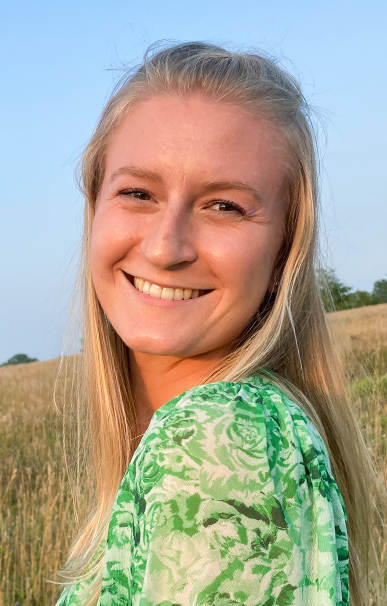 PROJECT
PROJECTClimate-smart Agriculture: Tracking Livestock Methane
ORGANIZATION / LOCATIONEnvironmental Defense Fund (EDF) -San Francisco, California
MENTOR(S)Peri Rosenstein, Senior Scientist, EDF
Certificate(s): Environmental Studies, Spanish Language and Culture
I researched methane emissions from livestock in the United States and globally. My work focused primarily on collecting the most disaggregated data possible on livestock emissions in order to better understand the various sources and intensity of emissions from different sectors and species within the livestock industry. Specifically, I sought to use this data to better understand how species, breed, feed type, feed intake and production system affect the amount of methane produced by an individual animal. Working on a team of scientists was a new but very welcome challenge that helped me improve my technical skills and pushed me to think in new ways. I completed a certification from the United Nations’ Food and Agriculture Organization to calculate national livestock methane emissions at the Tier II level, streamlined statistics across various measurements and conversion factors and learned the intricacies of livestock animals’ development and digestive processes. My favorite aspect of this internship was the volume of new information I learned every day.
-
She, Angelica ’26
Civil and Environmental Engineering
 PROJECT
PROJECTPotassium Isotopes in Plants: A Hydroponic Investigation With Arabidopsis
ORGANIZATION / LOCATIONHiggins Lab, Department of Geosciences, Princeton University - Princeton, New Jersey
MENTOR(S)John Higgins, Professor of Geosciences; Mason Scher, Ph.D. candidate, Geosciences
Potassium is a vital plant nutrient and the most abundant cation in plants. In addition to regulating the opening of a plant’s stomata, through which gas is exchanged for photosynthesis, potassium also helps with pH maintenance and enzyme activation. Though potassium transport systems in plants are well studied, little is known about potassium isotope fractionation — the relative partitioning of light and heavy isotopes — associated with those transport systems. To fill this gap, we conducted a hydroponic growth experiment with Arabidopsis, a model plant, to investigate the relationship between potassium isotopic compositions and a plant’s transport system. I started the seeds in a control condition with plenty of potassium before transferring them to growth buckets supplied with nutrient solutions of varying potassium concentrations. I recorded plant growth, replenished nutrient solutions and sampled the plants after the experiment. I also dried and ground the plant parts into powders to be dissolved in nitric acid and analyzed for potassium concentration and isotopic composition. As the specks of seeds grew into tall plants with budding flowers, so, too, did my confidence in experimental work and aspirations to create environmental change through research, engineering or both.
-
Strupp, Cole ’26
Molecular Biology
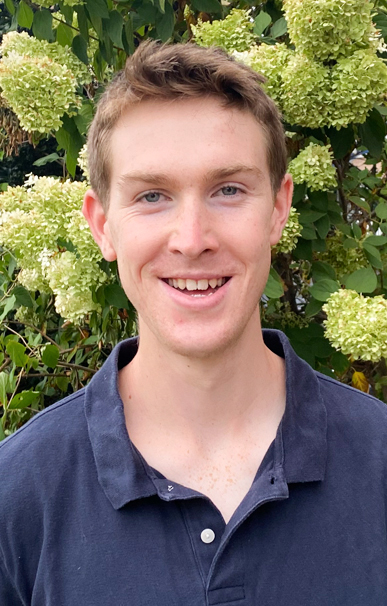 PROJECT
PROJECTHealth and Conservation at the Human-Domestic Animal-Wildlife Interface in Madagascar
ORGANIZATION / LOCATIONMetcalf Lab, Department of Ecology and Evolutionary Biology, Princeton University - Antananarivo, Madagascar; Betampona Natural Reserve, Madagascar
MENTOR(S)C. Jessica E. Metcalf, Associate Professor of Ecology and Evolutionary Biology and Public Affairs; Fidisoa Rasambainarivo, Postdoctoral Research Associate, High Meadows Environmental Institute; Benjamin Rice, Associate Research Fellow, High Meadows Environmental Institute
Certificate(s): Global Health and Health Policy, Quantitative and Computational Biology
I researched the prevalence of the zoonotic parasite Toxoplasma gondii among native carnivores in Madagascar’s rainforests. T. gondii is an invasive pathogen in Madagascar. The parasite only reproduces sexually in cats, which were introduced to the island relatively recently with the arrival of humans. As deforestation and settlement pushes humans (and their pet cats) closer to the island’s endemic carnivores, the threat posed by toxoplasmosis could intensify. To assess the current prevalence of the disease, I spent nearly a month in the Malagasy rainforest trapping and tracking native carnivores in order to perform physical examinations and collect blood samples. I also helped trap and examine lemurs, poultry and rodents to assist other researchers at the reserve. In the lab, I tested heart tissue for T. gondii infection by performing DNA extraction, polymerase chain reaction amplification and gel electrophoresis. The project concluded with data analysis in the program R. This internship exposed me to the excitement and challenges of fieldwork and scientific inquiry as a whole. I gained appreciation for the interconnectedness of environmental, animal and human health. I plan to continue studying disease ecology in future.
* This internship is connected to the HMEI Biodiversity Grand Challenges project, “Biodiversity Conservation and Health at the Human-Domestic Animal-Wildlife Interface in Madagascar.”
-
Wen, Sarina ’26
Chemical and Biological Engineering
 PROJECT
PROJECTProbing Microbial Colonization of Plants During Drought to Enable Microbiome-mediated Resilience in Crops
ORGANIZATION / LOCATIONConway Lab, Department of Chemical and Biological Engineering, Princeton University - Princeton, New Jersey
MENTOR(S)Jonathan Conway, Assistant Professor of Chemical and Biological Engineering
Certificate(s): Biotechnology, Neuroscience
I worked at the Stony Ford Seed Farm and Conway Lab at Princeton University, where I gained valuable laboratory and field skills by working on various projects related to agriculture and crop resilience. For the drought project, I planted seeds and crafted a watering system that puts plants through a simulated drought. This setup allows for later sampling and investigation of the microbiomes to gain knowledge of plant-microbial interactions during droughts. In another project, I tagged, organized and documented over 1,500 okra plants to later harvest to evaluate for seed oil content in hopes of discovering a new alternative and more sustainable oil source. In the laboratory, I worked to purify and extract DNA from Arabidopsis plants and performed polymerase chain reactions to identify primers for future research. I also performed lab tests to determine whether plants were homozygous for certain genes. I loved learning about what can be accomplished through chemical and biological engineering and cannot wait to do more of this type of research.
* This internship is connected to the HMEI Water and the Environment Grand Challenges project, “Probing Microbial Colonization of Plants During Drought to Enable Microbiome-Mediated Resilience in Crops.”
-
Wong, Natalie ’25
Ecology and Evolutionary Biology
 PROJECT
PROJECTFarm Project Field Assistant
ORGANIZATION / LOCATIONRubenstein Lab, Department of Ecology and Evolutionary Biology, Princeton University - Princeton, New Jersey
MENTOR(S)Daniel Rubenstein, Class of 1877 Professor of Zoology, Emeritus, Professor of Ecology and Evolutionary Biology, Emeritus; Gina Talt, Project Manager, Food Systems, Office of Sustainability
Certificate(s): Environmental Studies
Along with my co-interns in the Rubenstein Lab, I investigated the effects of mutualisms among the “three sisters” crops — corn, beans and squash — on plant growth and health. Indigenous groups have implemented the practice of planting the three sisters together for centuries, but the potential benefits of this system for sustainable agriculture in a climatically uncertain world have yet to be studied robustly. On the farm, I learned how to prepare the field using organic agriculture techniques, planted different types of seeds and set up experimental configurations within the constraints of outdoor conditions. Then, I used the software JMP to visualize trends and perform statistical tests on the data we collected. Overall, I found the project’s interdisciplinary nature to be the most fascinating and rewarding aspect and I gained knowledge about Native American history in the Princeton area. I hope to continue fusing scientific and humanistic research in my independent project to explore my primary area of interest: building a more planet- and people-friendly food system.
- Innovation and a New Energy Future
-
Barnes, Rees ’26
Electrical and Computer Engineering
 PROJECT
PROJECTInvestigating India’s Future Need for Electrical Power Transfer
ORGANIZATION / LOCATIONEnergy Systems Analysis Group, Andlinger Center for Energy and the Environment, Princeton University - Princeton, New Jersey
MENTOR(S)Eric Larson, Senior Research Engineer, Andlinger Center for Energy and the Environment; Ganesh Hegde, Postdoctoral Research Associate, Andlinger Center for Energy and the Environment; Cecelia Isaac, Associate Professional Specialist, Andlinger Center for Energy and the Environment
I worked with the Energy Systems Analysis Group and the Zero-carbon Energy Systems Research and Optimization Laboratory to work toward decarbonizing India’s electricity grids. I used ArcGIS and other geographical information systems to map the country’s major grid infrastructure by applying geographical data to independent photos provided by India’s government. Then, I began investigating how shifting the locations of India’s power plants would affect the need for interregional power transfer capacity (i.e., the ability to share energy across different grid sections). This experience taught me a lot about the different kinds of research. Up to this point, my experiences largely focused on hard sciences, so working with non-physical data was initially challenging, but my appreciation for the work grew immensely, and I found myself enjoying it. I came into this internship solely interested in developing new energy technologies, but I left as someone more intrigued by the implementation and policy surrounding our global energy future.
-
Bates, Mason ’25
Electrical and Computer Engineering
 PROJECT
PROJECTSmall Clean Fusion Reactor Shields
ORGANIZATION / LOCATIONPrinceton Plasma Physics Laboratory - Princeton, New Jersey
MENTOR(S)Samuel Cohen, Director, Program in Plasma Science and Technology, Princeton Plasma Physics Laboratory
I worked with the Princeton Plasma Physics Laboratory to investigate a more energy efficient neutron shield design for the Princeton Field Reversed Configuration (PFRC) fusion reactor. To keep operators safe and equipment functional, such a shield must be able to block high energy neutrons, a byproduct of the PFRC’s fusion reaction, but it must not block the magnetic fields required for radio frequency heating to avoid siphoning off wasted energy. I designed and conducted experiments to investigate the electrical properties and radio frequency penetration through shields of packed stainless-steel spheres, a proxy for electrically conductive high temperature shielding materials. I also performed calculations to model the Hertzian contact mechanics of conductive spheres. I mapped the magnetic fields produced by our antennas through various shield models to evaluate their energy efficiency. The experience taught me hands-on skills in radio frequency design, electrical engineering experimentation and plasma physics. I’ve learned a lot about nuclear fusion and the avenues it may open for clean energy in the future.
-
Bender, Leilani ’24
Civil and Environmental Engineering
 PROJECT
PROJECTWind Tunnel Construction and Experimentation on Umbrella Forms
ORGANIZATION / LOCATIONCreative and Resilient Urban Engineering (CRUE) and Structural Health Monitoring (SHM) Research Groups, Department of Civil and Environmental Engineering, Princeton University - Princeton, New Jersey
MENTOR(S)Maria Garlock, Professor of Civil and Environmental Engineering, Princeton University; Branko Glisic, Professor of Civil and Environmental Engineering, Princeton University; Antonio Navarro-Manso, Associate Professor, University of Oviedo
My project aimed to test the resilience of kinetic umbrellas to wind. The aims of this summer were to finish the construction of a wind tunnel, construct a balance to measure forces and compare preliminary results of wind testing on model kinetic umbrellas with the results from the University of Oviedo in Spain. We constructed the nozzle of the wind tunnel, connected its modular pieces and created and troubleshot the balance. Then, we tested the umbrella using different angles to compare the results obtained from the University of Oviedo, on a different sized wind tunnel. The most rewarding part of the internship was when the wind tunnel was finally turned on after many weeks of hard work.
-
Chan, Dorothy ’26
Civil and Environmental Engineering
 PROJECT
PROJECTA Case Study on the Future of Peaker Plants in New York City
ORGANIZATION / LOCATIONEnergy Systems Analysis Group, Andlinger Center for Energy and the Environment, Princeton University - Princeton, New Jersey
MENTOR(S)Eric Larson, Senior Research Engineer, Andlinger Center for Energy and the Environment; Cecelia Isaac, Associate Professional Specialist, Andlinger Center for Energy and the Environment
Certificate(s): Sustainable Energy, Urban Studies
New York operates on a transmission bottleneck, forcing its most densely populated areas to rely on peaker plants — outdated fossil fuel plants that only run a few times a year during periods of “peak” demand. Peakers are typically located in environmental justice communities, cost millions of dollars to maintain and produce highly polluting emissions, all of which bring cause for their retirement as soon as possible. For my research project, I first ranked which peakers should be retired first based on technical, environmental and financial factors represented by the capacity factor, surrounding air pollution and operating costs of each plant, respectively. Then, I used a least-cost optimization tool for electricity resource planning to model New York’s electrical grid in 2025, 2030 and 2040. I established these basic ranking and timeline frameworks in hopes that they may be further used in other urban areas that rely on peaker plants. I especially want to highlight the prioritization of disadvantaged communities in transitioning to a zero-emissions future. This internship allowed me to explore my interests in energy systems and urban planning, which I plan to continue pursuing through my concentration and certificates.
-
Devre, Yagiz ’26
Computer Science
 PROJECT
PROJECTDensity Functional Theory-based Machine Learning Reactive Force Fields for Water and Aqueous NaCl and CO2 Solutions
ORGANIZATION / LOCATIONCarter Group, Department of Mechanical and Aerospace Engineering, Princeton University - Princeton, New Jersey
MENTOR(S)Emily Carter, Gerhard R. Andlinger Professor in Energy and the Environment, Professor of Mechanical and Aerospace Engineering; John Mark Martirez, Staff Research Scientist, Princeton Plasma Physics Laboratory
Certificate(s): Environmental Studies, Finance, Statistics and Machine Learning
I delved into the innovative realm of carbon dioxide (CO2) capture and storage through mineralization in seawater. My project aimed to understand the molecular processes underlying CO2 mineralization into inert solids. I employed multi-level simulations, encompassing quantum mechanics and molecular dynamics, to explore the dynamics of CO2 hydration and bicarbonate formation in the presence of calcium and magnesium ions. I also developed machine-learned atomic interaction potentials tailored for aqueous CO2 systems involving calcium ions, magnesium ions and chloride ions, utilizing data from density functional theory-molecular dynamics simulations and refined simulation methodologies to generate datasets for potential development. This experience gave me valuable insights into quantum mechanics simulations, molecular dynamics and machine-learning techniques. I was particularly intrigued by how intricate atomic-scale interactions could drive large-scale environmental solutions and the machine-learning aspect of the algorithms utilized. This internship significantly influenced my academic trajectory by inspiring me to incorporate computational modeling and environmental research into my future endeavors. It has guided me toward a more focused pursuit of sustainable chemistry and environmental applications, shaping my senior independent project and long-term career aspirations in scientific research and innovation.
-
Dong, Angel ’25
Civil and Environmental Engineering
 PROJECT
PROJECTWind Tunnel Construction and Experimentation on Umbrella Forms
ORGANIZATION / LOCATIONCreative and Resilient Urban Engineering (CRUE) and Structural Health Monitoring (SHM) Research Groups, Department of Civil and Environmental Engineering, Princeton University - Princeton, New Jersey
MENTOR(S)Maria Garlock, Professor of Civil and Environmental Engineering, Princeton University; Branko Glisic, Professor of Civil and Environmental Engineering, Princeton University; Antonio Navarro-Manso, Associate Professor, University of Oviedo
Certificate(s): Architecture and Engineering, East Asian Studies
My project aimed to develop kinetic structures for coastal defense. These structures are umbrellas with a hyperbolic paraboloid, saddle-like shape, with a hinge to adjust it to different angles. They can act as sources of shade when upright in normal conditions but can be tilted to act as a flood barrier in hazardous conditions. I focused on testing these umbrella structures for performance under wind using a wind tunnel that we constructed. Then, I compared our results to results obtained from the University of Oviedo in Spain, where the same structure was tested. I learned a lot about wind engineering through my internship, as well as many new skills including 3D modeling and printing, the program MATLAB and how to operate different power tools. I enjoyed the hands-on construction experience and the conversations we had working alongside our professors every day. This experience has helped me be more confident in applying for graduate school. It has also convinced me to try participating in more research during my time here at Princeton as an undergraduate student.
-
Frudit, Helena ’25
Mechanical and Aerospace Engineering
 PROJECT
PROJECTEstimating Solar Rooftop Potential and Investigating Small-scale Generation in the United States
ORGANIZATION / LOCATIONClimate Central - Princeton, New Jersey
MENTOR(S)Jennifer Brady, Manager of Analysis and Production, Climate Central; Eric Larson, Senior Research Engineer, Andlinger Center for Energy and the Environment, Princeton University
I worked at Climate Central on WeatherPower, a platform that estimates solar and wind electricity generation based on installed capacity and the weather forecast. My objectives were twofold: to improve the reporting of small-scale facilities and to design a tool to convey the intrinsic value of solar energy. For my first goal, I identified datasets that included solar photovoltaic installations with a capacity below one megawatt and adjusted the current methodology. For the second goal, I planned to create a platform that could estimate the solar rooftop potential in various geographic resolutions and translate that potential into metrics such as monetary values. I studied the feasibility of creating such a tool, developed a methodology and created a proof of concept. I gained significant technical experience with the software ArcGIS Pro and improved my programming knowledge in Python. This internship also exposed me to the nonprofit world and to research outside of universities. It was fascinating to work with people from different academic backgrounds toward the goal of communicating the realities of climate change. This experience has reinforced my desire to generate a positive impact in the renewable energy field and convey the unprecedented pace and scale of the energy transition.
-
He, Shuchen ’25
Operations Research and Financial Engineering
 PROJECT
PROJECTLocation Optimization for Electric Two-wheeler Charging Stations in South Bangalore
ORGANIZATION / LOCATIONEnergy Systems Analysis Group, Andlinger Center for Energy and the Environment, Princeton University - Princeton, New Jersey
MENTOR(S)Eric Larson, Senior Research Engineer, Andlinger Center for Energy and the Environment; Ganesh Hegde, Postdoctoral Research Associate, Andlinger Center for Energy and the Environment
To cut carbon emissions, the Indian government has set the ambitious goal of electrifying its transportation system by 2030, and the city of Bangalore aims to become “the Capital of Electric Vehicles” in India. It is estimated that the number of electric vehicles, especially two-wheelers, will grow significantly in Bangalore, which will lead to a soaring demand for public chargers. I studied where public electric two-wheeler chargers should be sited in south Bangalore. The location of chargers matters because the accessibility of charging infrastructures determines people’s willingness to adopt electric vehicles. I first collected traffic data from Bangalore government surveys and used ArcGIS software to clean and process the data before analyzing it in Python. Then, I formulated and solved an optimization problem to generate a set of optimal locations for electric two-wheeler chargers. This internship allowed me to apply textbook knowledge to real-world problems, encouraged me to think as a scholar and engineer, and allowed me to build valuable friendships with my mentors and colleagues. I plan to further develop this project into my senior thesis.
-
Kim, John ’25
Physics
 PROJECT
PROJECTCalcio-olivine Synthesis
ORGANIZATION / LOCATIONSustainable Cements Group, Department of Civil and Environmental Engineering and the Andlinger Center for Energy and the Environment, Princeton University - Princeton, New Jersey
MENTOR(S)Claire White, Associate Professor of Civil and Environmental Engineering and the Andlinger Center for Energy and the Environment; Kumaran Coopamootoo, Postdoctoral Research Associate, Andlinger Center for Energy and the Environment
Certificate(s): Engineering Physics, Materials Science and Engineering
I investigated the methods and conditions for synthesizing calcio-olivine (γ-Ca2SiO4), a silicate that could be used to reduce carbon emissions associated with cement production. The manufacturing of Portland cement is a substantial contributor to anthropogenic carbon emissions. Cement-based silicate constituents like calcio-olivine have demonstrated CO2 mineralization, which, if well understood, could be utilized to develop sustainable cement that cures with CO2. To further study the characteristics of calcio-olivine, synthesizing the material with a high purity level is essential. I aimed to optimize and perfect the synthesis process by modulating various synthesis parameters such as precursor molar ratio, heating rate, calcination temperature and time, and cooling rate. I used visual observations and X-ray diffraction to analyze the impact of different conditions parameters, and performed the Rietveld refinement technique on the X-ray diffraction data to ultimately calculate the degree of crystallinity. With this internship, I gained more experimental experience in materials science, a subject that I have always been interested in. After this project, I feel comfortable committing and delving deeper into the field. Moreover, I appreciated the opportunity to pursue my academic passion while also tackling climate-related issues.
-
Kreutzer, Albert ’25
Mechanical and Aerospace Engineering
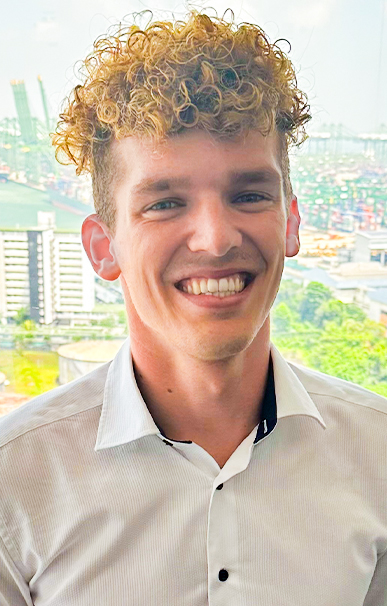 PROJECT
PROJECTOpportunities and Challenges of Liquified Petroleum Gas as a Marine Fuel
ORGANIZATION / LOCATIONGlobal Centre for Maritime Decarbonisation - Singapore
MENTOR(S)Lynn Loo, Chief Executive Officer, Global Centre for Maritime Decarbonisation
My project examined the uptake of energy-efficient technologies on ships. The problem of the uptake of these technologies can be split into two components: the split-incentive problem of financing, and the risk and uncertainty assessment regarding the technology. Our tasks contributed more to the uncertainty assessment of the efficiency measures, where we specifically looked at the devices and measures themselves and identified potential solutions for measuring their effectiveness and lowering the uncertainty. This involved integrating knowledge on the specific technology and the general shipping industry in order to identify the best possible solution. I also met with other stakeholders in the industry, which was an incredible opportunity to gain insight into their workflows, and an understanding of how the industry is working towards global environmental targets. All in all, this experience has taught me a lot about the challenges that the future holds, but has made me hopeful that the world will face these challenges.
-
Lim, Nicholas ’24
School of Public and International Affairs
 PROJECT
PROJECTSocial Norm Dynamics and Behavior and Organizational Change Toward Net-Zero Carbon Emissions
ORGANIZATION / LOCATIONBehavioral Science for Policy Lab, Princeton University - Princeton, New Jersey
MENTOR(S)Elke Weber, Gerhard R. Andlinger Professor in Energy and the Environment, Professor of Psychology and the School of Public and International Affairs; Jordana Composto, Ph.D. candidate, Psychology
My project aimed to identify behavioral barriers to decarbonization in the United States and Europe. I investigated the integration of low-carbon technology. The project’s foundation is a survey given to various stakeholders in the net-zero transition. I identified areas where progress was lacking and supplemented this with information on how polarization has impacted the integration of low-carbon technology. The data illustrated that there has been some progress — perceived levels of investment are high, as is prioritization of implementing low-carbon technology. However, the data indicated that levels of sharing of intellectual property is comparatively low, and levels of sharing of technological information were lower in polarized countries. Through this project, I gained experience with the program R, and how to analyze and present data. I enjoyed the opportunity to combine my passion for sustainability with my academic interest in polarization and I now have a greater understanding of the harmful effects of polarization in society. This research illustrates the importance of sharing information and intellectual property in the net-zero transition.
-
McLaughlin, Kat ’25
Anthropology
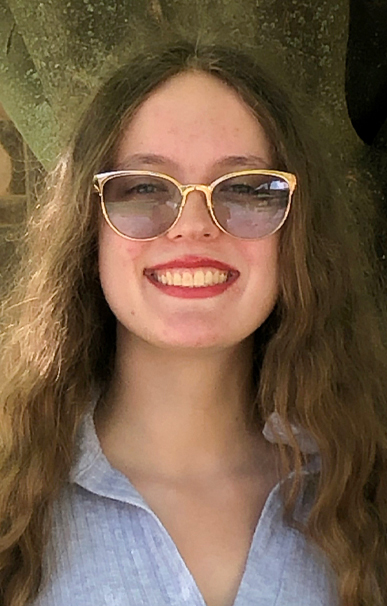 PROJECT
PROJECTEquitable Energy Transitions: Investigating Community Response
ORGANIZATION / LOCATIONBehavioral Science for Policy Lab, Princeton University - Princeton, New Jersey
MENTOR(S)Elke Weber, Gerhard R. Andlinger Professor in Energy and the Environment, Professor of Psychology and the School of Public and International Affairs, Princeton University; Holly Caggiano, Assistant Professor in Planning, University of British Columbia; Sara Constantino, Visiting Research Scholar, School of Public and International Affairs, Princeton University
Certificate(s): Environmental Studies
I investigated the community response to solar development in southern Pennsylvania. My goal was to use a qualitative approach to understand the diverse perspectives of local community members living or working close to solar projects. This work will provide insight into how communities will impact and be impacted at the local level by the necessary large-scale transition to net-zero. This perspective is vital for the implementation of an equitable energy transition. For this project, I transcribed and summarized scoping interviews to help drive and focus future research. I also sent out 1,000 mailers to recruit more interview participants, and I began preliminary thematic analysis, a reflexive and inductive method to identify patterns from our interviews. Thanks to my incredible mentors, I learned a lot about qualitative approaches to research, especially within the scope of behavioral science and psychology. I look forward to implementing these new perspectives and skills in future anthropological projects.
-
Morel, Stephane ’25
Electrical and Computer Engineering
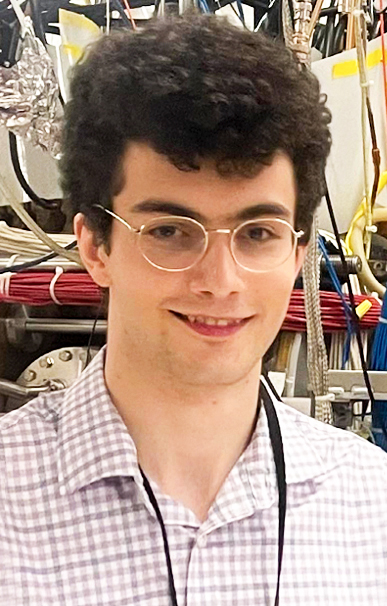 PROJECT
PROJECTAllowing Radio Frequency Passthrough in the Princeton Field Reversed Configuration Neutron Shields
ORGANIZATION / LOCATIONPrinceton Plasma Physics Laboratory - Princeton, New Jersey
MENTOR(S)Samuel Cohen, Director, Program in Plasma Science and Technology, Princeton Plasma Physics Laboratory
I investigated the possibility of creating radio frequency penetrant neutron shields for use in fusion research in future iterations of the Princeton Field Reversed Configuration fusion reactor (PFRC). This reactor would burn deuterium-helion (D-He3) fuel, turning them into easily stopped beta particles and protons, in contrast to the more commonly proposed deuterium-tritium reaction, which produces many high-energy neutrons that quickly degrade all known structural materials. A field reversed configuration produces fewer neutrons, but these must still be stopped to avoid degrading the superconducting coils. Most neutron shielding materials become electrically conductive at high temperatures and would therefore block one of the main heating methods of the PFRC. To overcome these issues, I helped design and conduct an experiment to test whether the radio frequency could penetrate a shield made of stainless steel spheres, which were being used as a proxy for high-temperature boron. I also conducted simulations in the programs openMC and Ansys Electrical Workbench to optimize the shape and size of slits in the shield, which would provide a much simpler design. Through this internship, I learned numerous simulation techniques, gained hands-on experience with radio frequency tools and acquired a more intimate understanding of fusion research.
-
Nucci, Giovanna ’25
Mechanical and Aerospace Engineering
 PROJECT
PROJECTB10-pellet Fluidized Bed for D-He3 Fusion Reactor Shielding
ORGANIZATION / LOCATIONPrinceton Plasma Physics Laboratory - Princeton, New Jersey
MENTOR(S)Samuel Cohen, Director, Program in Plasma Science and Technology, Princeton Plasma Physics Laboratory
Neutron shielding is essential to protect fusion-reactor components from damage. Energy from the neutron bombardment and from radiation must be extracted from the shielding at high efficiency for conversion to electricity. I researched whether shielding in the form of a fluidized bed of B-10 pellets contained between two concentric nonconducting cylinders can solve many problems faced by historical neutron shielding designs whose primary function was tritium breeding. I worked with another Princeton student to conduct simulations using CFD-ANSYS software to understand fluid flow and discrete element method simulations to understand particle behavior. The simulations were then compared to a single-cylinder simple setup that used a fast camera for data collection. We then analyzed the various forms of data and looked for connections to relevant literature to gain insight into the instabilities and challenges a fluidized bed would present. I gained valuable experience with ANSYS and a greater comprehension of the research process. Conducting a research project from start to finish — from reviewing literature, to running simulations, to experimentation itself and into analysis — meant I gained a breadth of knowledge that has helped me understand which phases of research I enjoy and want to pursue further.
-
Park, Chloe ’25
Chemistry
 PROJECT
PROJECTCarbon Negative Fuels and Plastics
ORGANIZATION / LOCATIONChirik Group, Department of Chemistry, Princeton University - Princeton, New Jersey
MENTOR(S)Paul Chirik, Edwards S. Sanford Professor of Chemistry; Hanna Cramer, Postdoctoral Research Fellow, Chemistry; Cherish Nie, Ph.D. candidate, Chemistry
Certificate(s): Classics, Environmental Studies
Most of the plastics we use daily, from shrink wrap to soda bottles, are in a class of polymers called polyolefins. Typical polyolefins are very stable materials that cannot be broken down completely, leading to accumulation in the environment. Developing depolymerizable polyolefins that can be broken down chemically is crucial since it enables plastics to be recycled infinitely, without worrying about subsequent losses in quality. I worked on developing a metal catalyst to break down a new type of polyolefin into its monomer building blocks. I was responsible for synthesizing different ligands — molecules that bind to a metal center and modify the catalytic activity of the overall complex — that were of interest to our project. I learned to set up chemical reactions, purify compounds and analyze the structures of molecules via nuclear magnetic resonance spectroscopy. I also gained practice presenting in front of other lab members and searching the chemical literature. Since the conclusion of my internship, I have decided to pursue a minor in Environmental Studies and I will continue to work with the Chirik Group on my junior independent project this year.
-
Petrovic, Marko ’24
School of Public and International Affairs
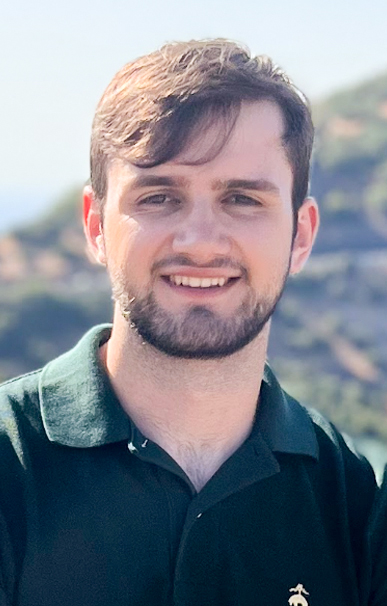 PROJECT
PROJECTSocial Norm Dynamics and Behavior and Organizational Change Toward Net-Zero Carbon Emissions
ORGANIZATION / LOCATIONBehavioral Science for Policy Lab, Princeton University - Princeton, New Jersey
MENTOR(S)Elke Weber, Gerhard R. Andlinger Professor in Energy and the Environment, Professor of Psychology and the School of Public and International Affairs; Jordana Composto, Ph.D. candidate, Psychology
Certificate(s): Cognitive Science, French Language and Culture
I worked with the Behavioral Science for Policy Lab to examine social norms and behavior in the context of the shift to net-zero emissions. The first project I completed involved selecting articles to be included in a meta-analysis of query theory, which is described in Professor Elke Weber’s research as “a psychological process model of preference construction that explains a broad range of phenomena in individual choice with important personal and social consequences.” I also worked to analyze a stakeholder survey for the Net-Zero project, which aims to measure the current global pace of transition toward net-zero. I found interesting correlations where business revenue explained both environmental, social and governance perceptions and behavior, but those behaviors and perceptions did not align. Moreover, I found preliminary evidence that societal trust could predict whether values were shared amongst different stakeholders. This research experience helped me gain better coding and data analysis skills and I plan to continue working on this project for my senior thesis. The experience gave me many new career insights, helped solidify my plans to pursue future psychological research and study, and to pursue a career that utilizes psychology to address environmental issues.
-
Razin, Azhar ’26
Chemical and Biological Engineering
 PROJECT
PROJECTUnderstanding Low Uptake of Energy-saving Devices on Board Ships
ORGANIZATION / LOCATIONGlobal Centre for Maritime Decarbonisation - Singapore
MENTOR(S)Lynn Loo, Chief Executive Officer, Global Centre for Maritime Decarbonisation; Shane Balani, Director of Research and Projects, Global Centre for Maritime Decarbonisation; Sanjay C. Kuttan, Chief Technology Officer, Global Centre for Maritime Decarbonisation
As an intern at the Global Centre for Maritime Decarbonisation, I investigated the low uptake of energy-saving devices on board ships and formed a data-driven commercial framework to overcome this environmental barrier. Retrofitting ships with energy-saving devices such as Flettner rotors, air lubrication systems and kites reduces overall fuel consumption, which reduces greenhouse gas emissions. However, the uptake of these technologies has been low, and this is attributed to the low financial incentive and consistent fuel savings data. I researched these energy-saving devices and analyzed the gaps in their effectiveness and measurability. Specifically, I focused on how sensors could potentially bridge the differences between theoretical and actual fuel savings for more accurate readings. To address the issue of low financial incentives, I researched the possibility of implementing a carbon credit system based on fuel savings. I also had the valuable opportunity to discuss my research with different stakeholders in the industry, including charterers, shipowners and device manufacturers. This project gave me the opportunity to gain technical skills such as coding, and to situate myself in professional environments. It also made me realize that every small contribution is important in reducing greenhouse gas emissions.
- Oceans and Atmosphere
-
Akiba, Sara ’26
Geosciences
 PROJECT
PROJECTA Revised Pleistocene View of the Effect of Climate on North Pacific Oxygenation From Foraminifera-bound Nitrogen Isotopes
ORGANIZATION / LOCATIONSigman Research Laboratory, Department of Geosciences, Princeton University - Princeton, New Jersey
MENTOR(S)Daniel Sigman, Dusenbury Professor of Geological and Geophysical Sciences, Professor of Geosciences; Matthew Lacerra, Ph.D. candidate, Geosciences
My project examined the effect of climate on ocean oxygenation in the Eastern Tropical North Pacific (ETNP), a region that is home to one of the ocean’s largest oxygen-deficient zones due to the region’s high productivity and slow circulation. When oxygen is depleted, organisms rely instead on nitrate for respiration via water column denitrification. During denitrification, the lighter nitrogen-14 is preferentially lost, which leads to increases in the ratio of nitrogen-15 to nitrogen-14. This signal of denitrification is incorporated into organic matter via nitrate assimilation in the surface ocean and preserved through burial on the seafloor. Fossil foraminifera-bound organic matter thus provides a record of the extent of denitrification in oxygen-deficient zones over glacial-interglacial periods. I prepared and analyzed foraminifera samples to extend an existing record of denitrification in the ETNP back to ~180,000 years before the present. I prepared samples by washing sediment material and selectively sorting two species of foraminifera for analysis. I also assisted in the wet chemistry stages of preparing the samples for mass spectrometry. This experience has strengthened my microscopy and laboratory skills and enhanced my understanding of paleo-oceanography and research processes, which has inspired me to do further research on this topic.
-
Avida, Maya ’26
Physics
 PROJECT
PROJECTDeep Learning for Prediction of Ocean Turbulence
ORGANIZATION / LOCATIONSchool of Oceanography, University of Washington - Seattle, Washington
MENTOR(S)Georgy Manucharyan, Assistant Professor, School of Oceanography, University of Washington; Scott Martin, Ph.D. candidate, School of Oceanography, University of Washington
Certificate(s): Statistics and Machine Learning, Sustainable Energy
Sea surface height (SSH) is a critical metric for understanding ocean eddies and currents. However, satellites are only able to measure SSH in one dimension, along the track in which they pass over the ocean. The standard method of estimating ocean currents uses optimal interpolation, which is an imperfect deterministic statistical method. This year, my research mentor Scott Martin published a paper demonstrating a new method for gridding SSH that significantly outperformed optimal interpolation by using machine learning to synthesize observations of SSH and sea surface temperature. My project used this new model to predict sea surface height up to 30 days into the future from raw satellite data. Being able to predict SSH forward in time would be very useful to oceanographers for a broad range of benefits, for example aiding oceanographers during field research by predicting the location of future eddies.
-
Checa, Isabella ’25
Geosciences
 PROJECT
PROJECTContrasting Air-Sea Carbon and Oxygen Fluxes in the Southern Ocean
ORGANIZATION / LOCATIONSchool of Oceanography, University of Washington - Seattle, Washington
MENTOR(S)Alison Gray, Assistant Professor, Physical Oceanography, University of Washington; Channing Prend, Postdoctoral Scholar, School of Oceanography, University of Washington
Certificate(s): Journalism
I aimed to unravel the connection between air-sea carbon and oxygen fluxes in the high-latitude Southern Ocean. My project focused on understanding the region’s carbon sink behavior by deciphering the relationship between dissolved oxygen (O2) and carbon dioxide (CO2) concentrations in data from biogeochemical floats in the Antarctic Southern Zone and Seasonal Ice Zone. I interpreted O2 and CO2 concentrations relative to surface saturation by making graphs and interpreting data from autonomous floats in the Southern Ocean Carbon and Climate Observations Modeling project. The experience enriched my analytical skills and expanded my knowledge of biogeochemistry, climate systems, the program Python, coding and scientific analysis. The most captivating aspect was decoding covariation patterns, notably in the Seasonal Ice Zone, where O2 and CO2 displayed a more direct correlation. I plan to incorporate the skills and information I learned into my upcoming junior paper. This experience solidified my aspiration to contribute to climate science and oceanography research and has given me a better understanding of the research process in the oceanography community. I hope to underline the importance of interdisciplinary research and its potential to illuminate critical aspects of our planet’s changing dynamics.
-
Cho, Rebecca
Geosciences
 PROJECT
PROJECTReconstructing the Marine Environmental Changes Across the Cretaceous-Paleogene Mass Extinction With Nitrogen Isotopes in Planktonic Foraminifera
ORGANIZATION / LOCATIONSigman Research Laboratory, Department of Geosciences, Princeton University - Princeton, New Jersey
MENTOR(S)Daniel Sigman, Dusenbury Professor of Geological and Geophysical Sciences, Professor of Geosciences; Crystal Rao, Ph.D. candidate, Geosciences
Reconstructions of how marine environments responded to past global disturbances can improve our understanding of the modern ocean. Foraminifera, marine microorganisms with calcium carbonate shells, preserve records of past ocean conditions in their shells. Approximately 66 million years ago, the Cretaceous-Paleogene mass extinction event caused significant ecological turnover and impacted the ocean’s biogeochemical cycling. Analyzing the nitrogen isotopic signatures of organic matter bound in foraminiferal shells from this period allows us to infer how this event impacted the marine nitrogen cycle and oxygenation. I assisted in generating the nitrogen isotope records of fossil planktonic foraminifera shells preserved in deep ocean sediment from western North Atlantic Ocean Drilling Program sites by washing and sieving bulk sediment to collect foraminifera shells and assisted with chemical cleaning and subsequent isotope analysis. I developed skills for the preparation of geologic marine sediments, foundational laboratory procedures in geochemistry, and a novel method for nitrogen isotope analysis developed in the Sigman Laboratory and its application to marine nitrogen cycling dynamics. This experience solidified my interest in paleoceanography and geochemical reconstruction with biological proxies and I plan to pursue research of similar significance to ascertain historical associations between the ocean and environmental perturbations.
-
Conatser, Clara ’25
Geosciences
 PROJECT
PROJECTReal-time Forecasting System for Hurricane Hazards and Risk
ORGANIZATION / LOCATIONHurricane Hazards and Risk Analysis Group, Department of Civil and Environmental Engineering, Princeton University - Princeton, New Jersey
MENTOR(S)Ning Lin, Professor of Civil and Environmental Engineering; Christine Blackshaw, Ph.D. candidate, Civil and Environmental Engineering; Avantika Gori, Ph.D. candidate, Civil and Environmental Engineering
Certificate(s): French Language and Culture, Music Performance
I studied and compared different methods of forecasting tropical cyclones. These methods included simple consensus, which compares several models that are weighted equally; and corrected consensus, in which models are weighted according to how accurately they predict storms in a training set. My analysis used a previously published equation to identify the best predictors of storm track (i.e., geographic location) and intensity. I also compared the absolute and relative error for the different models. Overall, I found that velocity, minimum pressure, latitude and longitude created the most accurate model. Through this project, I’ve become familiar with many ensemble forecasting methods and gained experience coding in the program Python. This knowledge will be invaluable for my junior project, which will focus on some aspect of tropical cyclone climatology.
-
Epstein-Gross, Dylan ’25
Computer Science
 PROJECT
PROJECTDeep Learning for Interpolation of Sea Surface Temperature
ORGANIZATION / LOCATIONSchool of Oceanography, University of Washington - Seattle, Washington
MENTOR(S)Georgy Manucharyan, Assistant Professor, School of Oceanography, University of Washington
Certificate(s): Statistics and Machine Learning
My project focused on developing deep learning models to interpolate missing values of sea surface temperature (SST) in gridded satellite data. SST is an extremely important variable for climate models and a key input for predicting ocean currents, but current high-resolution observations are incomplete due to cloud cover. To improve these valuable SST maps, I filled in the clouded data using state-of-the-art data processing pipelines and neural networks. I developed, trained and tested several neural network architectures in the lab and compared them with the deterministic statistical method used for interpolation in the literature. I found that certain models that process both spatial and temporal features of data were more effective than the baseline in reducing the deviation of interpolated values from actual temperature measurements. In the process, I researched many different neural network designs and learned a lot about the fascinating complexities of spatiotemporal interpolation as it relates to climate science. This research experience confirmed my passion for machine learning and inspired me to pursue it further during my time at Princeton, especially in conjunction with real-world problems like those found in oceanography.
-
Merchant, Charlotte ’24
Computer Science
 PROJECT
PROJECTSensitivity Analysis of pCO2 Estimations and Code Migration for Enhanced Climate Modeling
ORGANIZATION / LOCATIONMax Planck Institute for Meteorology - Hamburg, Germany; Ostend, Belgium
MENTOR(S)Peter Landschützer, Research Director, Flanders Marine Institute (VLIZ); Annika Jersild, Postdoctoral Researcher, Max Planck Institute for Meteorology
Certificate(s): Applied and Computational Mathematics, Statistics and Machine Learning
I studied the influence of sea surface temperatures on the estimation of the partial pressure of carbon dioxide (pCO2) globally. As a fundamental indicator of the ocean’s thermodynamic interactions, mixing phenomena, and air-sea interactions, sea surface temperature remains a key predictor of pCO2 in statistical, algorithmic and machine learning approaches. However, input sea surface temperature datasets are inconsistent across all pCO2 estimation methods due to differences in spatial and temporal focus, leading to sources combining different instrumental records and interpolation techniques. By evaluating the sensitivity of pCO2 predictions to different datasets, I aimed to distill the reliability of these estimations. In the program MATLAB, I used a previously described two-step neural network methodology for global pCO2 estimation. I also worked on migrating the MATLAB code into the program Python to enable execution within a high-performance computing environment. Engaging with an early implementation of machine learning in a climate science context motivated me to explore how other computational advancements can amplify the predictive capabilities of climate models. I also enjoyed the opportunity to engage in dynamic discussions with colleagues. The intellectually stimulating environment of the institute cemented my desire to pursue further study in climate computing.
-
Pagaduan, Lindsay Anne ’26
Chemistry
 PROJECT
PROJECTNitrous Oxide Fluxes From the Ocean and Estuaries
ORGANIZATION / LOCATIONThe Ward Lab, Department of Geosciences, Princeton University - Princeton, New Jersey
MENTOR(S)Bess Ward, William J. Sinclair Professor of Geosciences and the High Meadows Environmental Institute; Weiyi Tang, Postdoctoral Research Associate, Geosciences
Certificate(s): Environmental Studies, Korean Language
I investigated the production of nitrous oxide, a powerful greenhouse gas, in the Potomac River, which connects to the Chesapeake Bay. Specifically, I considered how a nearby sewage treatment plant could affect nitrous oxide production in the Potomac River. This is essential to understanding how land use contributes to greenhouse gas production and climate change. In water samples from the Potomac River, I measured the concentrations of three different nitrogen nutrients (ammonium, nitrite and nitrate) that play a role in producing nitrous oxide. Each nutrient concentration was measured with a different tool — a fluorometer for ammonium, a spectrophotometer for nitrite, and a NOx box machine for the combined nitrite and nitrate concentrations. I also helped prepare the water samples, nutrient standards and chemical reagents involved in each experiment. As a result of this experience, my technical lab skills have become more precise, and I gained a more complex understanding of greenhouse gas production. Through this internship, I have become more interested in participating in future studies and research on the chemistry behind climate change.
-
Shields, Hugh ’24
Geosciences
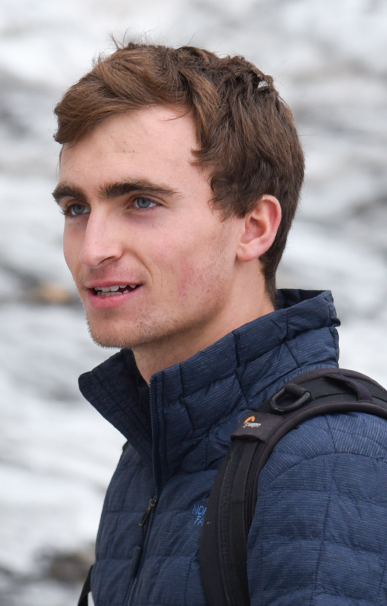 PROJECT
PROJECTSubZero: Discrete Element Sea Ice Modeling
ORGANIZATION / LOCATIONSchool of Oceanography, University of Washington - Seattle, Washington
MENTOR(S)Georgy Manucharyan, Assistant Professor, School of Oceanography, University of Washington; Brandon Montemuro, Postdoctoral Scholar, School of Oceanography, University of Washington
Certificate(s): Applied and Computational Mathematics, Statistics and Machine Learning
My research focused on pancake ice, a type of sea ice composed of rounded floes. Pancake ice is found in the Southern Ocean and has begun appearing more frequently in the Arctic due to climate change. The scale of pancake ice formation is too small to be resolved in today’s global climate models, and the processes that drive pancake ice formation are poorly understood. As pancake ice becomes more common, understanding its formation will be useful for naval navigation of an increasingly ice-free Arctic and will also help resolve ocean-atmosphere couplings in climate models. I worked to reproduce pancake ice in SubZero, a sea ice model that represents chunks of ice as an interacting set of polygons constrained by physical laws, that can fracture, weld together and interact with topography. Specifically, I developed code to represent wavefields in the model, improving corner fracturing of floes at a small scale, and building in the capability for wave curvature-induced fractures, which are necessary processes for pancake ice formation. Working with SubZero gave me insight into the computational challenges of working with a complex discrete element model and the difficulties of modeling processes that are hard to observe.
-
Villacorta, Sophia ’24
Geosciences
 PROJECT
PROJECTA Revised Pleistocene View of the Effect of Climate on North Pacific Oxygenation From Foraminifera-bound Nitrogen Isotopes
ORGANIZATION / LOCATIONSigman Research Laboratory, Department of Geosciences, Princeton University - Princeton, New Jersey
MENTOR(S)Daniel Sigman, Dusenbury Professor of Geological and Geophysical Sciences, Professor of Geosciences; Matthew Lacerra, Ph.D. candidate, Geosciences
I utilized the foraminifera-bound nitrogen isotope as a climate proxy to reconstruct past changes in water-column denitrification strength in the Eastern Tropical North Pacific (ETNP). I focused on the region’s oxygen deficient zone, which is formed through a combination of slow ventilation and high biological productivity. Reconstructing this zone’s history is important for understanding climate controls on various ocean processes, including oxygen content, circulation and nutrient cycling. Under low oxygen conditions, organisms rely on nitrate for respiration, which increases the ratio of nitrogen-15 to nitrogen-14 (15N/14N) in the remaining nitrate. This nitrate is eventually consumed by organisms such as foraminifera in the surface ocean. When the resulting organic matter is buried on the seafloor, it preserves the signal of water column denitrification strength through time. I processed samples by sieving sediment material under a microscope to isolate specimens of two species of foraminifera, Neogloboquadrina dutertrei and Globorotalia menardii. I also assisted in chemically cleaning the specimens to prepare them for nitrogen isotope measurements using a mass spectrometer. I now have a solid grasp of this ocean system and how nitrogen isotopes can be used as a proxy for paleoclimate, which I hope to examine further in my senior independent research.
-
Woodruff , Jaeda ’25
Geosciences
 PROJECT
PROJECTReal-time Forecasting System for Hurricane Hazards and Risk
ORGANIZATION / LOCATIONHurricane Hazards and Risk Analysis Group, Department of Civil and Environmental Engineering, Princeton University - Princeton, New Jersey
MENTOR(S)Ning Lin, Professor of Civil and Environmental Engineering; Christine Blackshaw, Ph.D. candidate, Civil and Environmental Engineering; Avantika Gori, Ph.D. candidate, Civil and Environmental Engineering
I compared the performance of various hurricane forecasting models from 2020-2022 and created a customizable forecasting tool trained on publicly available data. The tool uses a super ensemble approach, combining multiple independent models in a performance-based weighted average. This tool will be used to enable real-time, highly accurate hazard forecasting of factors such as wind speed, storm surge, rainfall and storm path on a county-by-county basis without reliance on subjective forecasts. Through this research experience, I learned a range of skills including data analysis in the program Python and how to use simple machine-learning models to minimize error with multiple linear regression. I also gained insights into the strengths and weaknesses of our current forecasting abilities and the unusually active 2020 and 2023 hurricane seasons. I plan to extend my work with extreme weather over the next semester by researching the historical relationship between greenhouse gases and extreme weather formation.
-
Yu, Tienne ’26
Molecular Biology
 PROJECT
PROJECTMolecular Biology of the Marine Nitrogen Cycle
ORGANIZATION / LOCATIONThe Ward Lab, Department of Geosciences, Princeton University - Princeton, New Jersey
MENTOR(S)Bess Ward, William J. Sinclair Professor of Geosciences and the High Meadows Environmental Institute; Samantha Fortin, Postdoctoral Research Associate, Geosciences
I worked with the Ward Lab to study the molecular underpinnings of the marine nitrogen cycle. My project focused on the nirK gene, which is involved in nitrite reduction, and the bacterial 16S gene, which is used to identify bacterial species. I contributed to two projects: a project studying the phylogeny and biogeography of bacterial species carrying the nirK gene, and a project studying nitrite oxidation in oxygen minimum zones, regions of the ocean with persistently low oxygen levels. For the first project, I organized and processed isolation source data of bacterial and archaeal nirK and assisted with creating a phylogenetic tree, a diagram that depicts the lines of evolutionary descent of genes from a common ancestor. For the second project, I optimized a PCR protocol for amplifying the 16S gene in water samples so that it can be sequenced to reveal the identities of the microorganisms within the samples. These results will provide a clearer understanding of how nitrite oxidation occurs in oxygen minimum zones. Through this internship, I gained valuable experience with molecular techniques and data processing and was introduced to oceanography and the marine nitrogen cycle.
- Water and the Environment
-
Burbank, Sarah ’25
Computer Science
 PROJECT
PROJECTUnderstanding Watershed Processes in Complex Terrain – Mountain Hydrology Field Camp
ORGANIZATION / LOCATIONIntegrated GroundWater Modeling Center, Department of Civil and Environmental Engineering, Princeton University - Rocky Mountain Biological Laboratory, Gothic, Colorado
MENTOR(S)Reed Maxwell, William and Edna Macaleer Professor of Engineering and Applied Science, Professor of Civil and Environmental Engineering and the High Meadows Environmental Institute; Harry Stone, Ph.D. candidate, Civil and Environmental Engineering
Certificate(s): African American Studies, Quantitative and Computational Biology
Mountainous watersheds are important for recharging the flow of Western American rivers. Understanding these watersheds is critical to modeling how climate change will affect water resources, however, they are difficult to model due to their complex terrain. I aimed to improve understanding of the spatial and temporal factors that govern soil moisture in mountainous watersheds and to investigate the viability of using machine learning to predict soil moisture in highly complex terrain from in situ measurements. I helped collect various data over a small drainage in Colorado’s East River watershed, including soil moisture data, meteorological data and drone-collected topographical characterization data. Then, I used these datasets to run a random forest regression machine-learning model to predict soil moisture. These methods can be used to extrapolate the findings of labor-intensive field campaigns to larger areas. I learned skills in data collection, organization and preprocessing. Seeing how research can translate data from real environmental trends into a computational output was exciting. The experience also gave me the opportunity to interact with successful people at all levels of academia, which enabled me to envision a future career path doing the same.
-
Carroll, Braeden ’26
Civil and Environmental Engineering
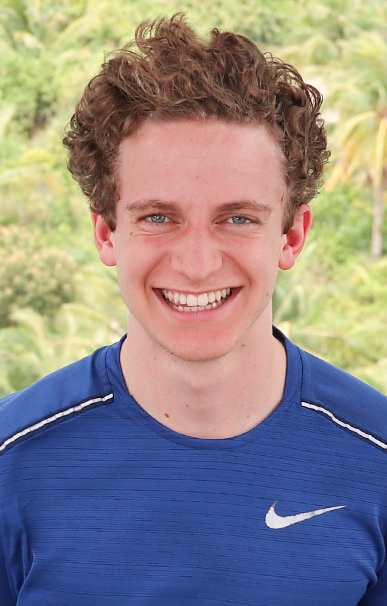 PROJECT
PROJECTSuper Typhoon Haiyan — Public Imaginaries and Lived Legacies
ORGANIZATION / LOCATIONBlue Lab, Effron Center for the Study of America, Princeton University - Princeton, New Jersey; Guiuan, Philippines; Manila, Philippines; Tacloban, Philippines
MENTOR(S)Allison Carruth, Professor of American Studies and the High Meadows Environmental Institute; Reed Maxwell, William and Edna Macaleer Professor of Engineering and Applied Science, Professor of Civil and Environmental Engineering and the High Meadows Environmental Institute; Mario Soriano, Postdoctoral Research Associate, High Meadows Environmental Institute
I worked with a small team within the Blue Lab to synthesize lessons learned in the 10-year recovery process since Super Typhoon Haiyan, a devastating tropical cyclone in the Philippines. This research involved interviewing government officials, academics, nongovernmental organization leaders and storm survivors, as well as visiting resettlement villages, weather forecasting stations and disaster memorials. From this research, we aimed to build a podcast to share the perspectives, experiences and voices of those affected by the storm. During our fieldwork in the Philippines, I alternated between the roles of interviewer, sound engineer, note taker and photographer. After the audio collection process, I created a seven-minute trailer for the podcast, which I presented to high school students as part of a science communication outreach program. Through this experience, I learned how to communicate research findings and ideas more effectively and I also gained significant experience in media editing and production, which are important skills in an increasingly digital world. I am glad I got to explore the impact of the environment in this creative way, and it has reaffirmed my desire to study civil and environmental engineering and understand how humanity interacts with natural and built environments.
-
Chen, Olivia ’25
Electrical and Computer Engineering
 PROJECT
PROJECTMolecular Simulation of Natural Organic Matter and Organic Contaminants
ORGANIZATION / LOCATIONInterfacial Water Group, Department of Civil and Environmental Engineering, Princeton University - Princeton, New Jersey
MENTOR(S)Ian Bourg, Associate Professor of Civil and Environmental Engineering and the High Meadows Environmental Institute
I worked to construct and simulate organic contaminants using molecular dynamics simulations. I began by creating input files to model per- and poly-fluoroalkyl substances (PFAS) or “forever chemicals”, a class of compounds that have recently received a lot of media attention due to their persistence in the environment and potential negative health effects. I also created input files for hydrophobic amino acids and fatty acids. I introduced the idea to model PFAS precursors, which contribute to PFAS levels but aren’t studied as much, and HFO refrigerants, which are a new class of refrigerants with a lower global warming potential but higher water pollution potential. In total, our team contributed over 30 new compounds to the Interfacial Water Group database. This work is important in revealing the physical properties of compounds and will also aid future development of removal techniques. Exploring chemistry in a computational way was new to me and I found it engaging to look at chemistry in an applied context. I am interested in taking this research a step further to look at these compounds in a more specific environment, and I plan to continue working with Professor Ian Bourg as a part of an independent research project.
-
DeFrates, Ashley ’25
Civil and Environmental Engineering
 PROJECT
PROJECTThe Interface of Hydrology and Machine Learning: Generating Better Information for Decision-makers and Educating the Decision-makers of the Future
ORGANIZATION / LOCATIONIntegrated GroundWater Modeling Center (IGWMC), Department of Civil and Environmental Engineering, Princeton University - Princeton, New Jersey
MENTOR(S)Reed Maxwell, William and Edna Macaleer Professor of Engineering and Applied Science, Professor of Civil and Environmental Engineering and the High Meadows Environmental Institute; Lisa Gallagher, Education and Outreach Specialist, IGWMC, Department of Civil and Environmental Engineering
Meteorological forcings are the weather inputs that drive hydrological models and govern the behavior of water in hydrologic simulations. Therefore, the accuracy of a model is heavily dependent on the accuracy of the forcings used in its development. My research focused on analyzing the temperature and precipitation forcing products used in the ParFlow-CONUS2 model, an integrated hydrologic model developed by the Integrated GroundWater Modeling Center that resolves groundwater flow across the United States at 1 km resolution. I compared forcing products to observed data for multiple water years, making visual representations of spatial statistics such as relative bias. In addition to this research, I also helped develop and deliver educational modules at The Watershed Institute’s Watershed Academy for High School Students. It is becoming increasingly important that we understand our groundwater resources as the impacts of climate change persist, making both hydrologic modeling and scientific education crucial in the fight for a sustainable future. Engaging in this morally fulfilling work while improving my coding and scientific communication skills made this project a rewarding experience that inspired me to pursue further studies in hydrology.
-
DiCenzo, Pia ’24
Mechanical and Aerospace Engineering
 PROJECT
PROJECTRheology of Polyelectrolytes in Aqueous Salt Solutions
ORGANIZATION / LOCATIONComplex Fluids Group, Department of Mechanical and Aerospace Engineering, Princeton University - Princeton, New Jersey
MENTOR(S)Howard Stone, Donald R. Dixon ’69 and Elizabeth W. Dixon Professor of Mechanical and Aerospace Engineering; Pedro de Souza, Postdoctoral Research Associate, Chemical and Biological Engineering; Jonghyun Hwang, Ph.D. candidate, Mechanical and Aerospace Engineering
Certificate(s): Robotics and Intelligent Systems
I researched how charged polymers dissolved in water respond to deformation under various conditions. This area of study is called polyelectrolyte rheology. I used a rheometer to look at how factors like salt concentration, salt type and pH affect the viscosity of these aqueous polymer solutions. I systematically completed measurements for various combinations of variables for two different polymers. Through this work, I gained experience in the lab and using new equipment, and explored a new topic that was beyond the scope of my classwork. For me, the most interesting aspect of this work is its environmental applications as they involve water filtration and soil remediation. I am interested in continuing research on this topic as part of my senior independent work because it has introduced me to the intersection of two of my main interests: fluid mechanics and environmental conservation.
-
Frudit, Helena ’25
Mechanical and Aerospace Engineering






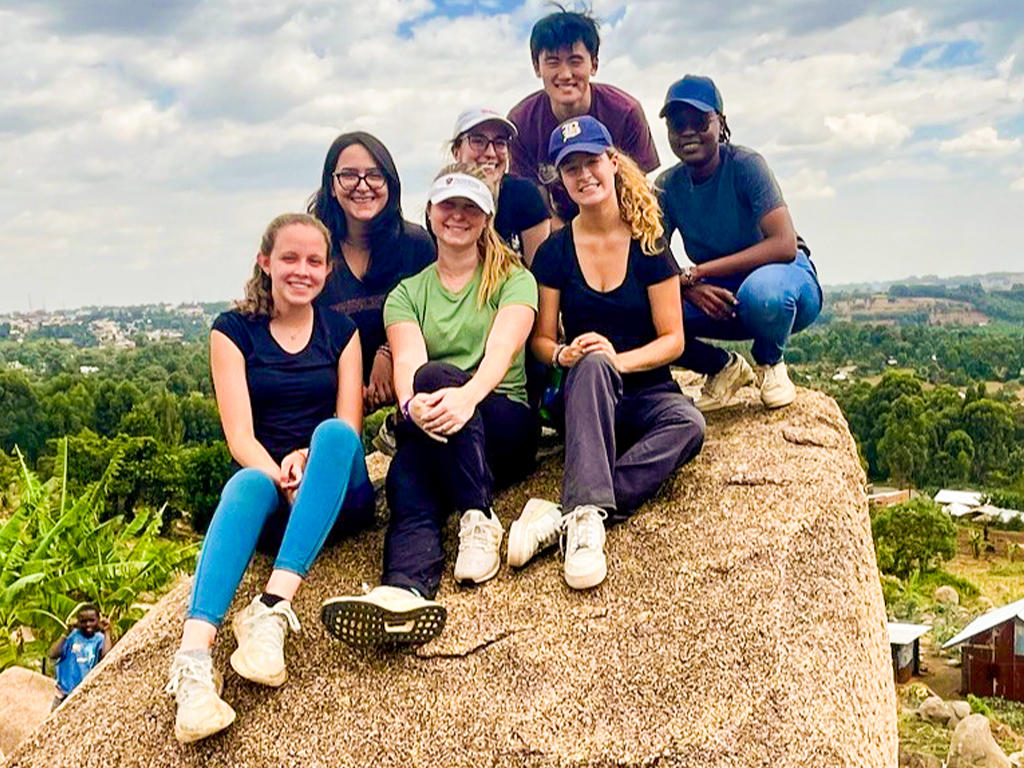 PROJECT
PROJECTNyabohanse Water Supply
ORGANIZATION / LOCATIONEngineers Without Borders (EWB), Princeton Chapter, Kenya - Kuria West, Migori County, Kenya
MENTOR(S)Sigrid Adriaenssens, Professor of Civil and Environmental Engineering, Princeton University; Roger Price, Responsible Engineer in Charge, EWB; Moses Sikuku Wakwabubi, Responsible Engineer in Charge, EWB
In Migori County, Kenya, many towns face limited access to clean water and water distribution infrastructure has yet to be established in many rural areas. Residents often rely on unsanitary water from nearby rivers, particularly during the dry season, and governmental agencies do not have the resources to reach rural areas with treated water. Seven members of Princeton’s chapter of Engineers Without Borders traveled to Nyabohanse in the Kuria District of Migori County. There, we spent several weeks working with key community and government stakeholders, evaluating potential solutions, visiting existing infrastructure and speaking with dozens of families in the Nyabohanse region to lay the groundwork for our largest project yet. This project aims to connect Nyabohanse residents to the existing regional water infrastructure, in collaboration with Rev. David Duveskog Primary School, the Lake Region Development Program, and the Migori County Water and Sanitation Company.
-
Gomes, Isabella ’25
Civil and Environmental Engineering






 PROJECT
PROJECTNyabohanse Water Supply
ORGANIZATION / LOCATIONEngineers Without Borders (EWB), Princeton Chapter, Kenya - Kuria West, Migori County, Kenya
MENTOR(S)Sigrid Adriaenssens, Professor of Civil and Environmental Engineering, Princeton University; Roger Price, Responsible Engineer in Charge, EWB; Moses Sikuku Wakwabubi, Responsible Engineer in Charge, EWB
Certificate(s): Urban Studies
In Migori County, Kenya, many towns face limited access to clean water and water distribution infrastructure has yet to be established in many rural areas. Residents often rely on unsanitary water from nearby rivers, particularly during the dry season, and governmental agencies do not have the resources to reach rural areas with treated water. Seven members of Princeton’s chapter of Engineers Without Borders traveled to Nyabohanse in the Kuria District of Migori County. There, we spent several weeks working with key community and government stakeholders, evaluating potential solutions, visiting existing infrastructure and speaking with dozens of families in the Nyabohanse region to lay the groundwork for our largest project yet. This project aims to connect Nyabohanse residents to the existing regional water infrastructure, in collaboration with Rev. David Duveskog Primary School, the Lake Region Development Program, and the Migori County Water and Sanitation Company.
-
Jacobson, Cynthia ’26
Civil and Environmental Engineering
 PROJECT
PROJECTMolecular Simulation of Natural Organic Matter and Organic Contaminants
ORGANIZATION / LOCATIONInterfacial Water Group, Department of Civil and Environmental Engineering, Princeton University - Princeton, New Jersey
MENTOR(S)Ian Bourg, Associate Professor of Civil and Environmental Engineering and the High Meadows Environmental Institute
Certificate(s): Sustainable Energy, Theater and Music Theater
Per- and polyfluoroalkyl substances (PFAS) are large, complex chemicals that have been used for decades in consumer and industrial products due to their heat resistance and water-proofing capabilities. All PFAS contain a fluorinated alkyl chain, whose strong carbon-fluorine bonds allow them to be highly resistant to degradation. Due to their widespread use and long-lasting nature, these contaminants have accumulated in groundwater, soil and air. As a class of contaminants, PFAS are difficult to mitigate because they encompass thousands of molecules with various structures and behavioral tendencies. I used molecular dynamics simulations to model a set of 34 diverse PFAS contaminants in order to assess their behavioral differences. These contaminants can now be simulated in various environmental systems such as air, water and clay, and biological systems such as lipid membranes and placental walls. Understanding how various subgroups of PFAS interact with these systems will inform future research on the efficacy of water treatment methods and the movement of PFAS in the human body. I look forward to continuing this research through my independent work.
-
Kim, Jamie ’24
Civil and Environmental Engineering
 PROJECT
PROJECTThe Interface of Hydrology and Machine Learning: Generating Better Information for Decision-makers and Educating the Decision-makers of the Future
ORGANIZATION / LOCATIONIntegrated GroundWater Modeling Center (IGWMC), Department of Civil and Environmental Engineering, Princeton University - Princeton, New Jersey
MENTOR(S)Reed Maxwell, William and Edna Macaleer Professor of Engineering and Applied Science, Professor of Civil and Environmental Engineering and the High Meadows Environmental Institute; Lisa Gallagher, Education and Outreach Specialist, IGWMC, Department of Civil and Environmental Engineering
Certificate(s): Applications of Computing
Providing accurate information about our water sources is important for future decision-makers to make wise and sustainable plans concerning water management. However, due to climate change, future environmental conditions have become further unpredictable, making it challenging to understand our water supplies. Using both physics-based and data-driven modeling in combination is essential for predicting conditions, as both modeling methods have advantages and disadvantages. To inform the integration of these methods, I analyzed the correlations between pumping data and climate condition variables and determined how groundwater pumping affects water table depth. I focused on implementing a machine learning, data-driven model that used a regression-enhanced random forest method to estimate water table depth in New Jersey. In addition, as part of the educational aspect of the internship, I helped teach at The Watershed Institute’s Watershed Academy for High School Students where I introduced the idea of pattern recognition and discussed the importance of data quantity and quality for training, all of which are fundamental to machine learning. Through this experience, I learned various practical skills in machine learning and data analysis which I hope to utilize for my senior thesis and other future work.
-
Kohler, Wiley ’25
Mathematics
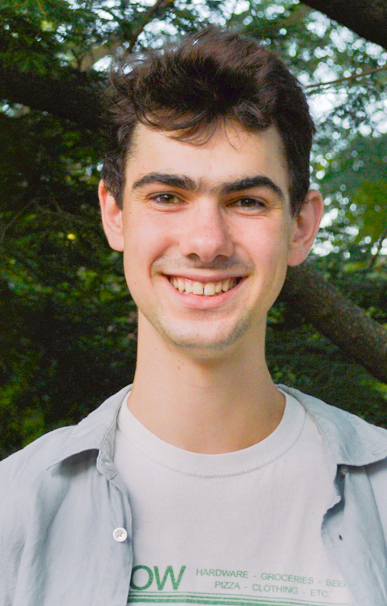 PROJECT
PROJECTUnderstanding Watershed Processes in Complex Terrain – Mountain Hydrology Field Camp
ORGANIZATION / LOCATIONIntegrated GroundWater Modeling Center, Department of Civil and Environmental Engineering, Princeton University - Rocky Mountain Biological Laboratory, Gothic, Colorado
MENTOR(S)Reed Maxwell, William and Edna Macaleer Professor of Engineering and Applied Science, Professor of Civil and Environmental Engineering and the High Meadows Environmental Institute; Harry Stone, Ph.D. candidate, Civil and Environmental Engineering
Much of the American West relies on the waters of the Colorado River, but the mountain processes that drive its flow are poorly understood. While models can help interested parties make water use decisions, they often fail to account for small-scale processes in small stream catchments. Through intense study of one such catchment, I aimed to better understand how conditions at these small stream catchments scale up to entire drainages. I worked with another intern and a Ph.D. candidate in an intensive field data collection campaign to gather vast amounts of hydrometeorological data, including soil moisture and streamflow data. I found this project exciting from a research perspective as a bridge between real-world observations and modeling. In addition, I preprocessed data for analysis, which included fixing data anomalies due to snowfall. I also developed a model for inferring the hydrologic properties of soil, which was an exciting opportunity to contribute to a larger project and ideate independently. I plan to refine and test my model as a part of my junior or senior independent work, and my summer experience will likely lead me to pursue similar research that includes a real-world field component in the future.
-
Krocheski-Meyer, Ava ’26
Computer Science






 PROJECT
PROJECTNyabohanse Water Supply
ORGANIZATION / LOCATIONEngineers Without Borders (EWB), Princeton Chapter, Kenya - Kuria West, Migori County, Kenya
MENTOR(S)Sigrid Adriaenssens, Professor of Civil and Environmental Engineering, Princeton University; Roger Price, Responsible Engineer in Charge, EWB; Moses Sikuku Wakwabubi, Responsible Engineer in Charge, EWB
In Migori County, Kenya, many towns face limited access to clean water and water distribution infrastructure has yet to be established in many rural areas. Residents often rely on unsanitary water from nearby rivers, particularly during the dry season, and governmental agencies do not have the resources to reach rural areas with treated water. Seven members of Princeton’s chapter of Engineers Without Borders traveled to Nyabohanse in the Kuria District of Migori County. There, we spent several weeks working with key community and government stakeholders, evaluating potential solutions, visiting existing infrastructure and speaking with dozens of families in the Nyabohanse region to lay the groundwork for our largest project yet. This project aims to connect Nyabohanse residents to the existing regional water infrastructure, in collaboration with Rev. David Duveskog Primary School, the Lake Region Development Program, and the Migori County Water and Sanitation Company.
-
Lee, Maxwel ’26
Electrical and Computer Engineering
 PROJECT
PROJECTStreamWatch Water Quality Monitoring Program
ORGANIZATION / LOCATIONThe Watershed Institute - Pennington, New Jersey
MENTOR(S)Erin Stretz, Assistant Director of Science and Stewardship, The Watershed Institute; Jian Smith, StreamWatch Program Coordinator, The Watershed Institute
I worked with the StreamWatch program, a program at The Watershed Institute that collects data on the water quality of freshwater ecosystems in central New Jersey. As part of the program, weekly tests are performed for E. coli, turbidity, chloride, nitrate, and orthophosphate, providing insight into the overall health of the local aquatic ecosystem. My project centered around mapping the collected data in the software ArcGIS to create an interactive dashboard that presented the data for each of the 60 sites in an easily understandable manner on The Watershed Institute’s main website. The dashboard will be utilized to educate local communities about the health of various water bodies in New Jersey, helping to raise awareness about the severity of harmful algal blooms and the importance of monitoring aquatic health. During my internship, I also had the pleasure of helping educate people on water pollution issues during the annual Butterfly Festival. It was very rewarding to teach people about all the work I undertook throughout the summer.
-
Li, Christopher ’26
Civil and Environmental Engineering
 PROJECT
PROJECTStreamWatch Water Quality Monitoring Program
ORGANIZATION / LOCATIONThe Watershed Institute - Pennington, New Jersey
MENTOR(S)Erin Stretz, Assistant Director of Science and Stewardship, The Watershed Institute; Jian Smith, StreamWatch Program Coordinator, The Watershed Institute
The StreamWatch program at The Watershed Institute collects data on the water quality of freshwater ecosystems in central New Jersey by performing weekly tests for E. coli, turbidity, chlorides, nitrates and orthophosphates. These tests can give insight into the overall health of the local aquatic ecosystem. My project focused on using the software ArcGIS StoryMaps to create an interactive webpage about the Stony Brook-Millstone Watershed. This resource allows visitors to view water quality data from 60 sites monitored by the StreamWatch program and to learn about different forms of water pollution and current threats to the ecosystem. In addition to its value as an educational asset, data insights from this resource offer a foundation for The Watershed Institute to recommend and implement environmental initiatives to protect and restore natural habitats. Through this internship, I gained experience in ArcGIS and learned how to operate various laboratory equipment utilized in the testing of water samples. The experience also allowed me to cultivate a personal interest in developing solutions to aquatic ecosystem threats.
-
Miller, Sophia ’26
Chemical and Biological Engineering






 PROJECT
PROJECTNyabohanse Water Supply
ORGANIZATION / LOCATIONEngineers Without Borders (EWB), Princeton Chapter, Kenya - Kuria West, Migori County, Kenya
MENTOR(S)Sigrid Adriaenssens, Professor of Civil and Environmental Engineering, Princeton University; Roger Price, Responsible Engineer in Charge, EWB; Moses Sikuku Wakwabubi, Responsible Engineer in Charge, EWB
In Migori County, Kenya, many towns face limited access to clean water and water distribution infrastructure has yet to be established in many rural areas. Residents often rely on unsanitary water from nearby rivers, particularly during the dry season, and governmental agencies do not have the resources to reach rural areas with treated water. Seven members of Princeton’s chapter of Engineers Without Borders traveled to Nyabohanse in the Kuria District of Migori County. There, we spent several weeks working with key community and government stakeholders, evaluating potential solutions, visiting existing infrastructure and speaking with dozens of families in the Nyabohanse region to lay the groundwork for our largest project yet. This project aims to connect Nyabohanse residents to the existing regional water infrastructure, in collaboration with Rev. David Duveskog Primary School, the Lake Region Development Program, and the Migori County Water and Sanitation Company.
-
Nyakea, Shalyn ’25
Civil and Environmental Engineering






 PROJECT
PROJECTNyabohanse Water Supply
ORGANIZATION / LOCATIONEngineers Without Borders (EWB), Princeton Chapter, Kenya - Kuria West, Migori County, Kenya
MENTOR(S)Sigrid Adriaenssens, Professor of Civil and Environmental Engineering, Princeton University; Roger Price, Responsible Engineer in Charge, EWB; Moses Sikuku Wakwabubi, Responsible Engineer in Charge, EWB
In Migori County, Kenya, many towns face limited access to clean water and water distribution infrastructure has yet to be established in many rural areas. Residents often rely on unsanitary water from nearby rivers, particularly during the dry season, and governmental agencies do not have the resources to reach rural areas with treated water. Seven members of Princeton’s chapter of Engineers Without Borders traveled to Nyabohanse in the Kuria District of Migori County. There, we spent several weeks working with key community and government stakeholders, evaluating potential solutions, visiting existing infrastructure and speaking with dozens of families in the Nyabohanse region to lay the groundwork for our largest project yet. This project aims to connect Nyabohanse residents to the existing regional water infrastructure, in collaboration with Rev. David Duveskog Primary School, the Lake Region Development Program, and the Migori County Water and Sanitation Company.
-
Pinkerton, Anna ’23
Geosciences


 PROJECT
PROJECTStudy of Rock and Water Samples From Mpala Research Centre
ORGANIZATION / LOCATIONNiespolo Research Group, Department of Geosciences, Princeton University - Princeton, New Jersey
MENTOR(S)Elizabeth Niespolo, Assistant Professor of Geosciences
My project aimed to help establish a comprehensive geologic analysis of the Mpala Research Centre in central Kenya. The goal of this long term project is to determine the viability of groundwater in the region for use as drinking water or for crops. The field samples for this project are still in transit from Mpala Research Centre, so the majority of my work was to conduct a literature review and to gain familiarity with the necessary laboratory methods, for example thin section analysis and basic petrographic and geochemical analysis. Through this research experience, I have gained experience in fieldwork, lab work and literature review. My contributions to the project are in its groundwork, and understanding the rocks in this region is essential to future research on the water found in nearby aquifers. The project is of a much larger scope than I had originally anticipated, and I have chosen to continue with the project as part of my senior thesis research.
* This internship is connected to the HMEI Water and the Environment Grand Challenges project, “Initiating Natural History and Groundwater Research at Mpala Research Center.”
-
Ritchie, Alyssa ’25
Chemistry
 PROJECT
PROJECTDesign of Light-activated Catalysts for Wastewater Contaminant Degradation
ORGANIZATION / LOCATIONSarazen Research Group, Department of Chemical and Biological Engineering, Princeton University - Princeton, New Jersey
MENTOR(S)Michele L. Sarazen, Assistant Professor of Chemical and Biological Engineering; Samuel Moore, Ph.D. candidate, Chemical and Biological Engineering
Certificate(s): Applications of Computing
Metal-organic frameworks (MOFs) have been the subject of much research in recent years due to their many applications and tunability. One subset of water-stable MOFs, the zirconium-based UiO series, has shown promise in the photocatalytic degradation of methylene blue when used in combination with hydrogen peroxide. Methylene blue is a dye used in many industrial applications and can be used as a probe for removing other dyes from wastewater. Allowing dyes to be released into the environment can harm aquatic ecosystems. While some methods currently can remove methylene blue from wastewater, using MOFs could allow the dye to be recovered and reused, presenting a cost-effective and eco-friendly alternative to current approaches. Over 8 weeks, I ran reactions testing methylene blue degradation under various conditions. I gained knowledge in using many different instruments, laboratory techniques and the overall research process. I look forward to continuing to learn about environmental chemistry and metal-organic frameworks.
* This internship is connected to the HMEI Water and the Environment Grand Challenges project, “Design of Light-activated Catalysts for Wastewater Contaminant Degradation.”
-
Saka, Eslem ’26
Electrical and Computer Engineering






 PROJECT
PROJECTNyabohanse Water Supply
ORGANIZATION / LOCATIONEngineers Without Borders (EWB), Princeton Chapter, Kenya - Kuria West, Migori County, Kenya
MENTOR(S)Sigrid Adriaenssens, Professor of Civil and Environmental Engineering, Princeton University; Roger Price, Responsible Engineer in Charge, EWB; Moses Sikuku Wakwabubi, Responsible Engineer in Charge, EWB
In Migori County, Kenya, many towns face limited access to clean water and water distribution infrastructure has yet to be established in many rural areas. Residents often rely on unsanitary water from nearby rivers, particularly during the dry season, and governmental agencies do not have the resources to reach rural areas with treated water. Seven members of Princeton’s chapter of Engineers Without Borders traveled to Nyabohanse in the Kuria District of Migori County. There, we spent several weeks working with key community and government stakeholders, evaluating potential solutions, visiting existing infrastructure and speaking with dozens of families in the Nyabohanse region to lay the groundwork for our largest project yet. This project aims to connect Nyabohanse residents to the existing regional water infrastructure, in collaboration with Rev. David Duveskog Primary School, the Lake Region Development Program, and the Migori County Water and Sanitation Company.
-
Zhang, Justin ’24
Civil and Environmental Engineering






 PROJECT
PROJECTNyabohanse Water Supply
ORGANIZATION / LOCATIONEngineers Without Borders (EWB), Princeton Chapter, Kenya - Kuria West, Migori County, Kenya
MENTOR(S)Sigrid Adriaenssens, Professor of Civil and Environmental Engineering, Princeton University; Roger Price, Responsible Engineer in Charge, EWB; Moses Sikuku Wakwabubi, Responsible Engineer in Charge, EWB
Certificate(s): Visual Arts
I researched lithium extraction in the United States. Lithium is an alkali metal essential for most electric vehicle batteries and grid-scale energy storage, but its mining is damaging and irreversible. I wanted to understand the competing narratives behind the green energy transition and inherently unsustainable extractive systems. Working with my co-interns and postdoctoral researchers in Princeton’s Blue Lab, I compiled an archive of statements from government agencies and mining corporations and secondary literature from environmental studies and the energy humanities. Additionally, I worked to identify potential stakeholders to interview, including environmental activists, mining corporation executives, affected Native American tribes, and ranchers. I participated in fieldwork in Gaston County, North Carolina; Pasadena, California; and northern Nevada. There, I conducted semi-structured interviews about residents’ experiences living near planned lithium mines. The first season of our podcast, “Mining for the Climate,” focuses on a junior mining company whose project, Carolina Lithium, has raised concerns among locals about noise, dust, water contamination and the future of their rural community. Working with the Blue Lab, interacting with environmental activists, and observing the insufficiency of environmental legislation has reaffirmed my desire to pursue a career that protects biodiversity and equitable access to federal lands.



